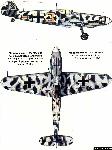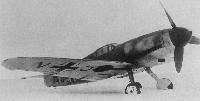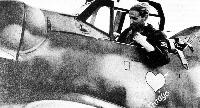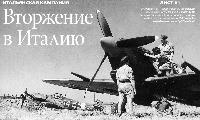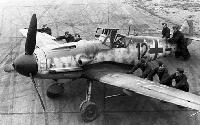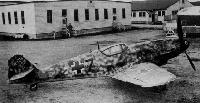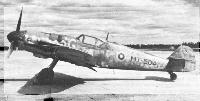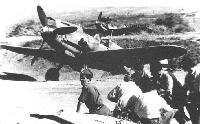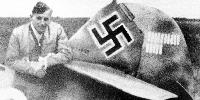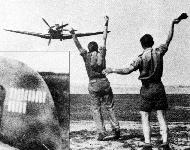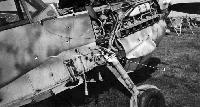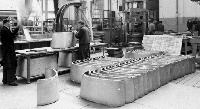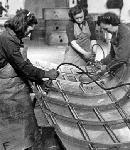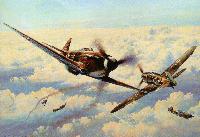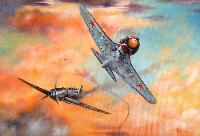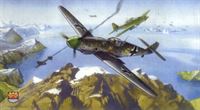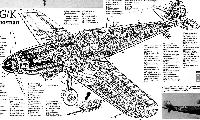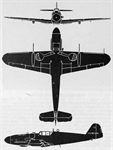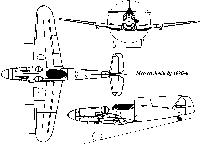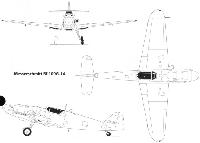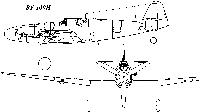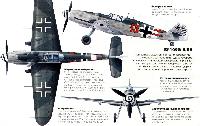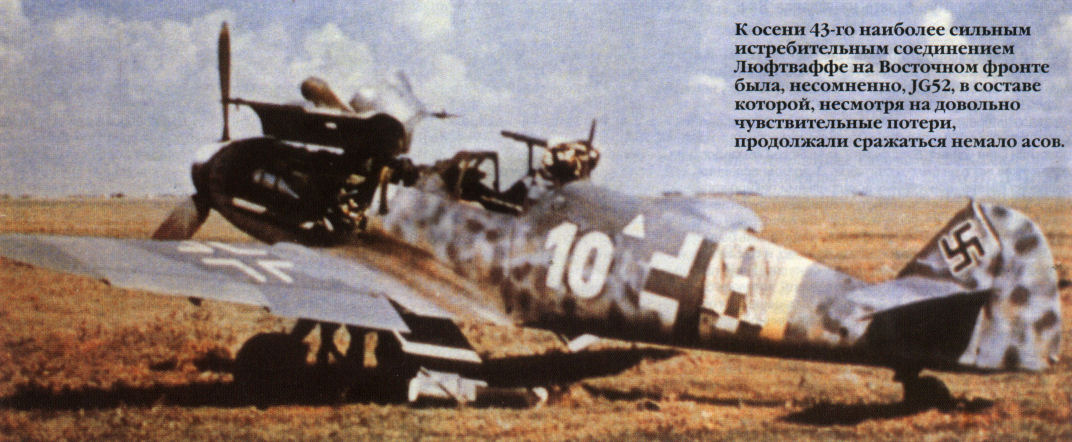
Варианты
- Messerschmitt - Bf.109 / Bf.109B / Bf.109C / Bf.109D - 1935 - Германия
- Messerschmitt - Bf.109E - 1938 - Германия
- Messerschmitt - Bf.109T - 1939 - Германия
- Messerschmitt - Bf.109F - 1940 - Германия
- Messerschmitt - Bf.109G - 1942 - Германия
- Messerschmitt - Bf.109K - 1944 - Германия
- Messerschmitt - Bf.109Z Zwilling - 1944 - Германия
- Hispano - HA-1109/HA-1112 Buchon - 1945 - Испания
- Avia - S-199 - 1947 - Чехословакия
- Jurca - MJ-9 One-Oh-Nine - 1972 - Франция
Bf.109G
Одноместный истребитель, цельнометаллический моноплан с закрытой кабиной и убирающимся шасси с хвостовым колесом. Спроектирован в КБ фирмы "Байерише Флюгцойгверке" (BFW) под руководством В.Мессершмитта. Первый полет опытный образец Bf 109V1 совершил в августе 1935 г. Серийное производство началось в феврале 1937 г. и продолжалось во все нарастающих масштабах до конца войны. Bf 109 выпускались в Германии на заводах фирм BFW (позднее "Мессершмитт") в Аугсбурге, "Эрла машиненверк" в Лейпциге, "Винер-Нойштадтер флюгцойгверке" в Винер-Нойштадте и Делитце, "Физелер" в Касселе, "Арадо" в Варнемюнде, AGO в Ошерслебене, а также в Румынии на заводе IAR в Брашове, в Венгрии - "Гиори Вагонгиар Гиор" в Гиоре. Всего изготовлено 30 573 Bf 109 всех вариантов. Самолет состоял на вооружении с марта 1937 г. в Германии, с 1940 г. - в Венгрии, Югославии, Болгарии, Словакии, с 1941 г. - в Румынии, с 1943 г. - в Италии и Финляндии.
Основные серийные модификации:
- Bf 109B с мотором Jumo 210Da, вооружение 2x7,9;
- Bf 109C с мотором Jumo 210Ga, вооружение 4x7,9;
- Bf 109D с мотором Jumo 210Da, вооружение 4x7,9; измененные выхлопные патрубки, усиленное крыло;
- Bf 109E с мотором DB601A-1, вооружение 4x7,9 или 2x7,9+2x20 или 3x20;
- Bf 109T - вариант с укороченным взлетом, истребитель-бомбардировщик (первоначально палубный), мотор DB601N;
- Bf 109F c мотором DB601E, измененная носовая часть, округлые законцовки крыла, нет подкосов стабилизатора, вооружение 1x20+2x7,9; на поздних сериях усиленная бронезащита, протектированные бензобаки, установка тропических противопыльных фильтров;
- Bf 109G с мотором DB605 (модификаций А, AC, AM, ASZM, D), многочисленные подмодификации, в т.ч. с гермокабиной, деревянной хвостовой частью, подвеской НУРС и дополнительным вооружением; основное вооружение 1x20+2x7,9, или 1x20+2x13, или 1x30+2x13;
- Bf 109K с мотором DB605 (модификаций DM, DBM, DCM), измененный фонарь кабины, убирающееся хвостовое колесо, вооружение 1x30+2x13 с возможностью установки дополнительного вооружения.
Боевой дебют Bf 109B состоялся в Испании в декабре 1936 г. К сентябрю 1939 г. самолет Мессершмитта являлся уже основным истребителем Люфтваффе (большинство составляли машины модификации Е). Участвовал во всех основных операциях на всех фронтах. Применялся как дневной и ночной истребитель, истребитель-бомбардировщик, тактический разведчик. Продолжал выпускаться до самого конца войны. В Финляндии состоял на вооружении до 1948 - 1949 гг., в Болгарии - до 1946 г., в Швейцарии - до мая 1948 г.
Bf 109G-6||
Размах:||9,92 м
Длина:||8,85 м
Моторы, количество х мощность:||1x1800 л.с.
Взлетная масса, максимальная:||3400 кг
Максимальная скорость:||621 км/ч
Практический потолок:||11500 м
Дальность:||1000 км
Описание:
- Bf.109G
- Bf.109 (разв.)
- Messerschmitt Bf 109
Фотографии
-
АвиаМастер 2006-08 / А.Марченко, И.Сеидов - Домой вернутся все! /Авиация в лицах/
Bf 109G-2 - "новогодний подарок" 127-му ИАП. Судя по всему, этот истребитель, прибывший на пополнение эскадры JG3 "Удет", прослужил в ней совсем недолго, так как на него даже не успели нанести желтые ЭБР немецких самолетов восточного фронта
-
АвиаМастер 2006-02 / А.Марданов - Восемь пишем, два в уме /На фронтах Великой Отечественной/ (2)
Bf 109G-2, на котором 19 апреля 1943 года был сбит оберфельдфебель Рудольф Мюллер
-
Мир Авиации 1992-01 / Ю.Рыбин - Снова о Рудольфе Мюллере
Мессершмитт Me 109G-2 обер-фельдфебеля Р.Мюллера 6 эскадрилья 5 истребительной эскадры. Аэродром Алакуртти, апрель 1943г.
-
История Авиации 1999-01 / Ю.Рыбин - Expertenstaffel за Полярным кругом /Боевой путь/ (4)
Bf109G-2 командира 7/JG5 обер-лейтенанта Вайссенбергера. Заполярье, лето 1943г.
-
АвиаМастер 1999-04 / Ю.Рыбин - Expertenstaffel за Полярным кругом /Боевой путь/ (4)
"Мессершмитт" Me 109G-2 командира 7/JG5 Теодора Вайссенбергера, июнь 1943г.
-
Мир Авиации 1998-01 / В.Белов - Теодор Вайссенбергер /Асы мира/
Messerschmitt Bf 109G-2/R6 "белая 4" Теодора Вайссенбергера. Самолет принадлежал 7./JG 5. Петсамо (Финляндия), весна-лето 1943г.
-
Мировая Авиация 38
"Желтый 5" - это позывной Bf 109G-2 фельдфебеля Антона Хафнера из 6./JG 51, воевавшего в августе 1942 года в районе Орла. Хафнер продолжил увеличивать свой личный счет в боях над Средиземным морем, летал на Fw 190, прежде чем снова вернулся в Россию.
-
Мировая Авиация 21
Обер-лейтенант Ралль летал на этом Bf.109G-2, когда был командиром 8./JG-52, август 1942 года.
-
Авиация и Космонавтика 1995-11 / С.Горожанин - Лучшие асы-истребители мира
Истребитель Мессершмитт Bf-109G-2 Германа Графа, командира 9-го отряда 52 гешвадер (9/JG52)
-
Авиация и Время 2005-05 / О.Каминский - "Мессершмитты" над Кубанью
Bf 109G-2 л-та Цвитана Галича из "хорватского штаффеля" 15(Kroat)/JG52. Над Кубанью он одержал 10 (+2 неподтвержденные) победы, в т.ч. сбил МДР-6 (20 апреля) и 2 Spitfire из 57-го ГИАП (3 и 25 мая)
-
АвиаМастер 2005-02 / А.Заблотский, Р.Ларинцев - Вдали от Сталинграда /На фронтах Великой Отечественной/
Истребитель Bf 109G-2 из состава 7./JG54, на котором 6 января 1943г. был сбит и погиб фельдфебель Йозеф Брехтель.
-
Мировая Авиация 96
Регистрационный номер: MT-212 [2] 24 марта 1943 года Ютилайнен на этом Bf 109G-2 первым из финских летчиков сбил Пе-2. На самолете Bf109G он одержал 58 побед.
-
АвиаПарк 2009-02 / А.Заблотский, Р.Ларинцев - Целеустремить по транспортам в портах! /На фронтах Великой Отечественной/
Регистрационный номер: MT-213 [2] Финский Bf 109G-2 из 2-й эскадрильи 24-го истребительного авиаполка, аэродром Суулаярви, весна 1944г.
-
История Авиации 2000-05 / А.Андреев - Ойва Туоминен /Асы мира/
Регистрационный номер: MT-220 "Мессершмитт"Bf109G-2 прапорщика Ойвы Туоминена из состава эскадрильи LeLv26. Карелия, лето 1944г.
-
АвиаМастер 2002-05 / М.Морозов - Бомбы на Констанцу /На фронтах Великой Отечественной/
Me 109G-2 из 7-й истребительной флотилии румынских ВВС. Предположительно, с истребителями этой части 20-21 августа вели бои над Констанцей летчики ВВС ЧФ.
-
Авиация и Время 1998-06 / И.Бориславов - Таранные удары в небе Болгарии (1943-1944гг.) /Аэроархив/
Bf 109G-2 поручика Списаревского из 3/6-го орляка
-
Мировая Авиация 78
Messerschmitt Bf 109G. Этот истребитель Bf 109G-2/Trop из 6-й эскадрильи 2-й группы 51-й истребительной эскадры "Molders" в июне 1943 года базировался в Каза-Цеппера в штабе ПВО Сардинии. Перед прибытием на средиземноморский ТВД 2-я группа 51-й истребительной эскадры воевала в СССР, а позже сражалась в Германии, Австрии, на Балканах и в Венгрии.
-
АвиаМастер 2000-03 / Г.Минский - "Зарубки на прикладе" /Боевая палитра/ (2)
Bf-109G-2/trop оберлейтенанта Франца Гетца (63 победы), III группа 53-й истребительной эскадры "Люфтваффе", Северная Африка, октябрь 1942г.
-
Мировая Авиация 1
Bf 109G-2/R1 Trop, 3./JG 53. Январь 1943. За 100 одержанных на Восточном фронте побед лейтенант Вильгельм Кринус был награжден Рыцарским крестом с дубовыми листьями. Этот самолет (серийный номер 10 804) одержал затем 14 побед на Средиземноморье и был подготовлен к возвращению Кринуса из короткой командировки в штаб авиакрыла (Gruppenstab) в составе I./JG 53. Однако Кринусу не довелось полетать на заново окрашенном для него самолете, поскольку 13 июня 1943 года он был сбит на побережье Туниса и попал в плен. Вместо него на этом истребителе летал в дальнейшем лейтенант Герхард Опель.
-
АвиаМастер 2004-04 / М.Морозов - Искра победы: советские ВВС в операции по прорыву блокады Ленинграда /На фронтах Великой Отечественной/
Bf 109G-2/R6 из состава 6-й эскадрильи 1-й группы 54-й истребительной эскадры Люфтваффе.
-
Авиация и Время 2016-03 / С.Вахрушев - Из первых, встретивших войну... (2)
Bf 109G обер-лейтенанта В. Новотны из I/JG54, разбитый при посадке 11 августа 1942 г. после боя с МиГ-3 из группы Ячменева
-
Авиация и Время 2005-05 / О.Каминский - "Мессершмитты" над Кубанью
Bf 109G-4 л-та Йозефа Цвернеманна из 9./JG52. С 15 апреля по 7 мая он одержал 3 (+1 неподтвержденную) победы
-
Авиация и Время 2014-02 / Т.Кузнецова - Мария Долина. Она воевала на пикирующем бомбардировщике
Bf109G-4 из 2./JG52 обер-фельдфебеля Рудольфа Тренкеля. 2 июня 1943 г. на Кубани этот летчик сбил 4 советских самолета Из них два Пе-2
-
АвиаМастер 2004-03 / Д.Хазанов, В.Горбач - Прелюдия к битве /Наш анонс/
Bf 109G-4, на котором был сбит фельдфебель А.Фишер из авиагруппы II/JG53.
-
История Авиации 2003-01 / В.Антипов, И.Уткин - Драконы с "птичьим крылом" /В строю советских ВВС/ (3)
Bf109G-4/R6 (сер. N 14997) унтер-офицера Герберта Мейсслера из состава 7./JG52, который был подбит в воздушном бою 28 мая 1943г. капитаном П.Тарасовым. Ранее этот истребитель принадлежал лейтенанту Эриху Хартману, на официальном счету которого к концу войны значилось 352 победы.
-
Мировая Авиация 1
Bf 109G-4/Trop, I./JG 77. Приблизительно январь 1943. Густая краска RLM 79 придает этому самолету лейтенанта Гейнца-Эдгара Берри, базировавшемуся в Матмата на юге Туниса, более темный вид чем это принято для войны в пустыне. Эскадрилья I./JG 77 до января 1942 года носила название I. (J)/LG 2 (LG = учебно-боевая) и сохранила прежнюю эмблему, где на фоне красной карты Британии изображена белая буква L. Берри одержал победы в 53 воздушных боях, а затем 25 июля 1943 года был сбит, когда сопровождал над Мессинским проливом группу военно-транспортных самолетов Ju 52/3.
-
История Авиации 34 / С.Алексеев, А.Булах, П.Каминский - Хроники Интрудеров /Ретроспектива/ (9)
Bf 109G-4 командира 8-й эскадрильи III/JG53 обер-лейтенанта Франца Шисса, аэродром Эль Аоина, февраль 1943 г. К моменту своей гибели 2 сентября 1943 г. в воздушном бою над Неаполитанским заливом Франц Шисс имел на счету 67 побед и был награждён "Рыцарским Крестом".
-
Мировая Авиация 1
Bf 109G-4/Z Trop, 8./JG 53. Приблизительно февраль 1943. Грубо нанесенные пятна желто-коричневой краски могут скрывать знак заместителя командира авиагруппы, - именно эту должность занимал летавший на этом Bf 109G обер-лейтенант Франц Шисс до своего перевода на должность командира эскадрильи. К своим имевшимся на тот момент 36 победам Шисс добавил еще 29, а затем 2 сентября 1943 был сбит истребителем P-38 Lightning. Буква Z в названии самолета указывает на то. что этот Bf 109G-4 был оснащен инжектором закиси азота, повышавшим мощность двигателя.
-
АвиаМастер 1999-04 / Д.Хазанов - Битва над Яссами /Хроника победы/
"Мессершмитт" Me 109G-5 из состава II/JG52, Румыния, май 1944г.
-
История Авиации 1999-01 / Ю.Рыбин - Expertenstaffel за Полярным кругом /Боевой путь/ (4)
Bf109G-6 командира II/JG5 гауптмана Карганико. Заполярье, осень-зима 1943г.
-
АвиаМастер 1999-04 / Ю.Рыбин - Expertenstaffel за Полярным кругом /Боевой путь/ (4)
"Мессершмитт" Me 109G-6 командира II/JG5 Хорста Карганико, июль 1943г.
-
АвиаМастер 1999-04 / Ю.Рыбин - Expertenstaffel за Полярным кругом /Боевой путь/ (4)
"Мессершмитт" Me 109G-6 командира 6/SG5 Генриха Эрлера, май 1943г.
-
АвиаМастер 2004-03 / Д.Хазанов, В.Горбач - Прелюдия к битве /Наш анонс/
Bf 109G-6 обер-фельдфебеля Р.Тренкеля из авиагруппы I/JG52.
-
Авиация и Время 2003-06 / В.Колечкин - Авиация в боях под Кировоградом в январе 1944г. (1)
Bf 109G-6 из I/JG 52, на котором предположительно летали оберлейтенанты М.Гайсслер и В.Тодт. Самолет был выведен из строя ночью 9 января 1944г. при атаке советскими танками аэродрома Малая Виска
-
Air Enthusiast 1971-12 / Model enthusiast
Bf 109G-6 of I/JG 52 at Leipzig (Rumania), summer 1944
-
АвиаМастер 2004-03 / Д.Хазанов, В.Горбач - Прелюдия к битве /Наш анонс/
Bf 109G-6 из авиагруппы I/JG52.
-
Мировая Авиация 21
На истребителе Bf 109G-4 с собственным именем "Christl" (в честь жены) летал Баркхорн, когда был командиром II./JG-52, август 1943 года.
-
Авиация и Время 2005-02 / В.Антипов, И.Уткин - "Скворцы" из стаи "Дракона" (крымская весна 1944г.)
Bf 109G-6 л-та Вальтера Вольфрума из 5./JG52 - участника боя с "Яками" 812-го ИАП 12.04.1944г.
-
Авиация и Космонавтика 2018-02 / ??? - Истребителю Як-3 50 лет
Германский истребитель Мессершмитт Bf 109G - главный противник нашей авиации в годы Великой Отечественной войны. Для противодействия таким самолетам как раз и создавался Як-3. На рисунке изображен Bf 109 модификации G-6
-
Авиация и Космонавтика 2012-04 / В.Бакурский - Они были лучшими?
Истребитель Bf 109G-6 - один из самолетов Эриха Хартмана
-
История Авиации 2000-06 / М.Морозов - Топи их всех /Крылья над морем/ (3)
Bf109G-6 командира 9/JG52 обер-лейтенанта Эриха Хартмана к моменту эвакуации 8 мая 1944г. немецкой авиабазы Херсонес одержал 223 победы.
-
Мировая Авиация 19
Этот Bf 109G-6 в зимнем камуфляже пилотировал капитан Эрих Хартман, назначенный командиром авиагруппы I./JG 52 в декабре 1944 года. Самолет нес на носу фюзеляжа персональную эмблему Хартмана - листья тюльпана, а под кабиной - красное сердце с именем его жены.
-
Авиация и Время 2005-02 / В.Антипов, И.Уткин - "Скворцы" из стаи "Дракона" (крымская весна 1944г.)
Bf 109G-6 штаффелькапитана Мато Дуковача - аса N 2 ВВС Хорватии из 15.(kroat)/JG52. Крым, апрель 1944г.
-
АвиаМастер 2002-05 / М.Морозов - Бомбы на Констанцу /На фронтах Великой Отечественной/
Me 109G-6 командира I группы 53-й истребительной эскадры Люфтваффе майора Юргена Хардера. Предположительно, с истребителями этой части 20-21 августа вели бои над Констанцей летчики ВВС ЧФ.
-
Авиация и Космонавтика 1999-01 / В.Дымич - Веселая охота на востоке Европы
Истребитель Bf 109G-6 командира II.JG 54 Ханса Ханна (март 1943г.)
-
Мировая Авиация 80
Bf 109G-6 "белая 1". 77-я истребительная эскадра приняла активное участие 8 обороне Сицилии. Данный самолет принадлежал обер-лейтенанту Эрнсту-Вильгельму Райнерту, в августе командовавшему 1-й эскадрильей. Райнерт стал самым результативным германским летчиком-истребителем в период кампании в Тунисе, а всего ас одержал в воздушных боях 174 победы.
-
АвиаМастер 2002-07 / В.Антипов - "Коммунист" из Люфтваффе: летчик-истребитель Альфред Гриславски /Авиация в лицах/
"Мессершмитт" Bf 109G-6 Альфреда Гриславски, Германия, осень 1943г.
-
Air Enthusiast 1971-12 / Model enthusiast
Bf 109G-6 of 11° Gruppo Caccia Terrestre, 3a Squadriglia “Diavoli", Villafranca, Verona, October 1944;
-
АвиаМастер 2001-04 / С.Степанов - "Зарубки на прикладе" /Боевая палитра/ (7)
"Мессершмитт" Bf109G-6 летчика Салетти из 3-й эскадрильи 2-й авиагруппы ВВС "Итальянской Социалистической Республики" (прогерманское государственное образование на севере Италии), октябрь 1944г.
-
Air Enthusiast 1971-12 / Model enthusiast
Bf 109G-6 of the Hungarian 102 Independent Fighter Group, summer 1944;
-
Авиация и Время 1995-04 / А.Котлобовский - В тени Люфтваффе (Венгерские ВВС. Март - сентябрь 1944г.) /Аэроархив/ (4)
Bf 109G-6 из 101-й ИАД, апрель 1944г.
-
АвиаМастер 2001-04 / С.Степанов - "Зарубки на прикладе" /Боевая палитра/ (7)
"Мессершмитт" Bf109G-6 лейтенанта Ласло Даниеля, истребительная группа 101/I венгерских ВВС, лето 1944г.
-
История Авиации 2003-01 / М.Жирохов, Г.Лопатко - Александру Шербэнеску /Асы мира/
Bf109G-6 командира 9-й истребительной авиагруппы ВВС Румынии капитана Александру Шербэнеску. Аэродром Текучи, Румыния, лето 1944г.
-
АвиаМастер 2003-07 / М.Жирохов - Новые союзники - бывшие враги: Румынские ВВС в боях против нацистской Германии /Фронтовые хроники/
"Мессершмитт" Bf 109G6, на котором румынский летчик капитан Кантакузино осенью 1944 года сопровождал бомбардировщик B-17, вывозивший из Румынии в южную Италию бывших американских военнопленных. Флаги США по бортам играют роль элементов быстрой идентификации. Внизу - личная эмблема пилота.
-
АвиаМастер 2003-07 / М.Жирохов - Новые союзники - бывшие враги: Румынские ВВС в боях против нацистской Германии /Фронтовые хроники/
"Мессершмитт" Bf 109G6 "локотенанта" (лейтенанта) Иона Галеа из 9-й авиагруппы румынских ВВС. Аэродром "Мишкольц", весна 1945г.
-
Air Enthusiast 1971-12 / Model enthusiast
Bf 109G-6 of the 14th Slovakian Fighter Squadron, Crimea, spring 1943;
-
Авиация и Время 1998-06 / И.Бориславов - Таранные удары в небе Болгарии (1943-1944гг.) /Аэроархив/
Bf 109G-6 подпоручика Маринопольского из 2/6-го орляка, аэродром Враждебна, весна 1944г.
-
Air Enthusiast 1971-12 / Model enthusiast
Bf 109G-6 of the Bulgarian 6th Fighter Regiment, Wrasdebna, April 1944;
-
Air Enthusiast 1971-12 / Model enthusiast
Регистрационный номер: J-706 Bf 109G-6 of Fliegerkompagnie 7 of the Swiss Fliegertruppe, autumn, 1944;
-
Авиация и Время 2016-05 / А.Харук - На страже нейтралитета. ВВС Швейцарии в годы Второй мировой войны (2)
Регистрационный номер: J-713 Bf 109G-6 из 7-й авиароты ВВС Швейцарии. Интерлакен, лето 1944 г.
-
Air Enthusiast 1971-09 / Z.Jerin - Emil versus the Luftwaffe
A Bf 109G-6 in postwar service. Pale grey finish overall with red spinner and white numeral.
-
Мировая Авиация 80
Bf 109G-6/Trop. Изображен самолет, на котором с аэродрома Комизо на Сицилии в июле 1943 года летал соттотененте Джузеппе Руццин. На самолете 154-й эскадрильи 3-й группы изображен красный черт - "Diavolo Rossi" - эмблема группы, а на вертикальном оперении - белый савойский крест.
-
АвиаМастер 2000-03 / Г.Минский - "Зарубки на прикладе" /Боевая палитра/ (2)
Bf-109G-6/R6 оберфельдфебеля Хайнриха Бартельса (99 побед), 11-я эскадрилья 27-й истребительной эскадры "Люфтваффе", Греция, сентябрь 1943г.
-
Мировая Авиация 57
Bf 109G-6/R6. Истребитель с красным бортовым номером "13", на котором в сентябре 1943 года с аэродрома Каламаки в Греции летал фельдфебель Генрих Бартельс. На руле направления изображены отметки о 56 сбитых самолетах. Всего Бартельс одержал 99 побед и стал кавалером Рыцарского креста.
-
Мировая Авиация 94
Регистрационный номер: MT-477 1-й лейтенант Микко Пасила летал на этом Bf 109G-6/R6 в последние два месяца боевых действий между Финляндией и СССР. Самолет изображен по состоянию на июль 1944 года (1-е звено 24-й истребительной эскадрильи, авиабаза Лаппинранта).
-
Мировая Авиация 251
Регистрационный номер: MT-461 Messerschmitt Bf 109. Одним из первых среди союзников Германии истребители Messerschmitt Bf 109 получила Финляндия - все они были различными модификациями Bf 109G-6. Здесь представлен Bf 109G-6/R6 из состава 3-й эскадрильи 24-го истребительного авиаполка, на котором воевали несколько финских летчиков-асов. На его счету - не менее восьми сбитых в июле 1944 года советских самолетов Ил-2 и Ла-5.
-
История Авиации 1999-01 / Ю.Рыбин - Expertenstaffel за Полярным кругом /Боевой путь/ (4)
Bf109G-6/U2 командира JG5 майора Эрлера. Норвегия, осень 1944г.
-
Мир Авиации 1998-01 / В.Белов - Теодор Вайссенбергер /Асы мира/
Messerschmitt Bf 109G-6AS/U2, на котором командир I./JG 5 Т.Вайссенбергер летал во Франции. Мондидье, июнь 1944г.
-
Авиация и Время 1995-04 / А.Котлобовский - В тени Люфтваффе (Венгерские ВВС. Март - сентябрь 1944г.) /Аэроархив/ (4)
Bf 109G-10 летчика Иштвана Фабиана из 101-й ИАД, осень 1944г.
-
АвиаМастер 2001-04 / С.Степанов - "Зарубки на прикладе" /Боевая палитра/ (7)
"Мессершмитт" Bf109G-10/U4 из истребительной группы 101/III венгерских ВВС, на котором в апреле 1945г. летал лейтенант Сенаши.
-
Мировая Авиация 188
Регистрационный номер: OK-BYH [3] Bf 109G-10/U4 воздушной полиции ЧССР. Данный самолет собрали в Чехословакии в послевоенное время из деталей, изготовленных еще во время войны.
-
Air Enthusiast 1971-12 / Model enthusiast
Bf 109G-10/U4 of the kroat.Jagdstaffel, Eichwalde, November 1944.
-
Мировая Авиация 127
Bf 109G-14. Несколько групп получили на вооружение вариант Bf 109 с более мощным мотором D6 605AM и обеспечивающим лучший обзор назад фонарем Галланда. Изображен самолет хорватской эскадрильи, который осенью 1944 года базировался в Эйхвальде.
-
АвиаМастер 2004-03 / М.Жирохов - Ас из Рильского монастыря: Болгарский летчик-истребитель Стоян Стоянов /Авиация в лицах/
"Мессершмитт" Bf 109G, на котором воевал Стоян Стоянов.
-
История Авиации 23 / В.Антипов, И.Уткин - Драконы с "птичьим крылом" /В строю советских ВВС/ (5)
Противник имел хотя и небольшие, но вполне боеспособные ВВС, основу которых составляли FW190F из состава II/SG2, Bf109G-6 из II/JG52 (фото), Bf110G-2 из 5/NJG200, а также гидропланы BV138 и Do24, базировавшиеся на Констанце. Нельзя было сбрасывать со счета и Bf109G-3 ВВС Румынии.
К осени 43-го наиболее сильным истребительным соединением Люфтваффе на Восточном фронте была, несомненно, JG52, в составе которой, несмотря на довольно чувствительные потери, продоложали сражаться немало асов. -
Air Enthusiast 1994-12 / W.Heron - On Parade
Регистрационный номер: RN228 [37], G-USTV [37] Wearing a hastily-applied ‘camouflage’ the Messerschmitt Bf 109 is none other than the famous Black 6, currently the only genuine airworthy Luftwaffe warbird anywhere in the world. Flown by Lt Heinz Ludemann of III/JG 77, Bf 109G-2/Trop w/nr 10639 Black Six (call-sign ‘PG+QJ’) was captured at Gambut Main (LG 139) on November 13, 1942. Crew from 3 Squadron RAAF could not resist the challenge to get the Gustav airworthy and with their codes ‘CV- V’, it was flown by the unit until it was ferried to Heliopolis on December 2, 1942. The Bf109 flew on to Lydda in Palestine on December 15, for evaluation by 209 Group. It flew to Shandur, Egypt, on February 21, 1943. Shipped to the UK via Liverpool, it arrived at Collyweston on December 26, 1943 and was given RAF camouflage, markings, and the serial RN228. [Editor’s collection] It first flew with 1426 Flight on February 19, 1944, later joining the Enemy Aircraft Flight at Tangmere. Moved to 47 MU at Sealand in April 1946, it was with GAFEC at Stanmore Park by 1949. Beyond Stanmore, the Gustav followed the AHB aircraft into storage at Wroughton and Fulbeck. It moved to Wattisham by 1961 and there it was the centre of an abortive restoration attempt led by F/L John Jeff Hawke. After allocation for use in the film Battle of Britain at Henlow in 1968, w/nr 10639 moved to Lyneham in October 1972 where it came under the authoritative attentions of F/L Russ Snadden and team, for an epic restoration to flying condition. In 1975, the Bf 109 moved to Northolt, in 1983 to Benson. It moved out of Benson on March 17, 1991 - under its own power - the patience and skills of Russ and many others well vindicated. With the ‘paperwork’ registration G-USTV, and in its original ‘Gambut’ colours it is flown from Duxford under a joint arrangement between the Imperial War Museum and the Ministry of Defence.
-
Aeroplane Monthly 1991-10 / M.Oakey - Grapevine
Регистрационный номер: G-USTV [37], RN228 [37] Messerschmitt Bf 109G 10639/G-USTV demonstrates the effectiveness of its desert camouflage over the ripening grain fields of Cambridgeshire in August 1991. Issued by the MoD five-and-a-half months after the fighter’s post-restoration maiden flight, this was the first air-to-air photograph of the aircraft to be released - an echo of the BAe/Shuttleworth publicity failure with the D.H.88 Comet racer in 1987.
-
Мировая Авиация 2
Регистрационный номер: G-USTV [37], RN228 [37] За годы Второй мировой войны было построено более 30000 Messerchmitt Bf109. Некоторые из них ныне восстановлены и могут подниматься в воздух. Этот Bf 109G принадлежит Британским королевским ВВС.
-
Мировая Авиация 2
Регистрационный номер: G-USTV [37], RN228 [37] С 1991 по 1997 годы единственным самолетом из Bf 109, на которых можно было летать, был Bf 109G-2/Trop WkNr 10639 "Black 6", принадлежащий военному музею в Даксфорде. После отступления немцев из Ливии этот самолет обнаружили английские летчики. Прослужив некоторое время в Австралии, он был передан базе Королевских ВВС в Коллиуэстоне для демонстрационных и оценочных полетов. Капитальный ремонт был проведен на базе в Линехэме в 1972 году, после чего самолет передали вначале в Нортхолт, а затем в Бенсон, где 17 марта 1991 года он выполнил свой первый после восстановления полет. Пилотировал его Рэг Хэллем. К сожалению, в 1997 году истребитель сильно пострадал во время посадки.
-
Air International 1996-03 / R.Whitford - Fundamentals of Fighter Design (2)
Регистрационный номер: G-USTV [37], RN228 [37] The Messerschmitt Bf 109 first flew in 1935 as an air superiority fighter. Only a relatively small fuel load was envisaged and it was decided that performance could be optimised by the use of small wings whose high wing loading could be offset by leading-edge slots and trailing-edge flaps. The fuselage was slim and the cockpit cramped, this emphasis being carried over to the undercarriage, which was of narrow track. These design features were later to become the major drawbacks of the aircraft.
-
Aeroplane Monthly 1993-08
Регистрационный номер: G-USTV [37], RN228 [37] -
Aeroplane Monthly 1991-06 / M.Oakey - Grapevine
Регистрационный номер: G-USTV [37], RN228 [37] First flown on March 17, 1991 at the end of an 18yr restoration, the MoD-owned Messerschmitt was scheduled to be officially rolled out at Benson on May 2, and to fly to its new base at Duxford shortly thereafter. However, as we went to press, engine problems looked likely to delay its move.
-
Air International 1991-06 / Flying colours
Регистрационный номер: G-USTV [37], RN228 [37] A fine example of a restored Second World War fighter is this Messerschmitt Bf 109G-2 which was rolled out at RAF Benson on 2 May 1991. ‘Luftwaffe’ enthusiasts will appreciate the accuracy of the markings which depict the original scheme of W.Nr. 10639 ‘Black 6’ of III/JG 77 when flying in support of Rommel's ‘Afrika Korps' in 1942. The overall scheme is ‘Sand Gelb (Temp) 79‘, with ‘Himmelblau 78’on the undersurfaces and fuselage sides. The first airworthy Gustav to be captured intact, the aircraft was shipped to the UK and given the RAF serial RN228 spending the rest of the war as part of No 1426 (Enemy Aircraft) Flight at Colleyweston. The aircraft will fly from Duxford for the next three years before retiring to the RAF Museum for permanent display.
-
Aeroplane Monthly 1991-06 / M.Oakey - Grapevine
Регистрационный номер: G-USTV [37], RN228 [37] The "Benson Messerschmitt", Bf 109G Werknr 10639/G-USTV, showing off its newly-completed paint scheme outside its hangar at RAF Benson in Oxfordshire on April 26, 1991. It wears the colours in which it was captured by the RAAF in Libya in 1942 - "Black Six" of JG 77.
-
Aeroplane Monthly 1991-06 / M.Oakey - Grapevine
Регистрационный номер: G-USTV [37], RN228 [37] As these pictures show, the Messerschmitt has been restored to an extremely high standard - as befits the world’s only real airworthy Bf 109 (all the other aircraft currently masquerading as 109s are Merlin-powered Spanish licence-built Hispano Buchons). If all goes to plan, G-USTV is expected to make its display-flying debut at Mildenhall on May 25-26, 1991, and should also be the star of the show at Duxford’s Classic Fighter Display on July 14.
-
Aeroplane Monthly 1993-08 / M.Oakey - Grapevine
Регистрационный номер: G-USTV [37], RN228 [37] Messerschmitts galore: Duxford’s incomparable Bf 109G-2 10639 G-USTV meets examples of the company’s Fritz Fend-designed microcar during a Messerschmitt Owners’ Club rally at the Cambridgeshire airfield on May 23, 1993.
-
Air Pictorial 2002-05
Регистрационный номер: G-USTV [37], RN228 [37] ‘Black 6’, the previously airworthy Messerschmitt Bf 109G-2, made its final journey when it arrived at the Royal Air Force Museum Hendon on March 10, 2002, going on public exhibition the following day.
-
Aeroplane Monthly 2000-01 / T.Harmsworth - The future of the past /Preservation in the 21st century/
Spanning the past and the future: genuine Messerschmitt Bf 109G-2 “Black 6” (seen here in temporary colours as “Red 3” for filming in April 1997) has wartime provenance, was a popular performer on the show circuit until its crash in 1997, and is now being rebuilt for museum display.
-
Aviation Historian 26
Регистрационный номер: D-FMGV This air-to-air photograph of the Hangar 10 Collection’s restored Messerschmitt Bf 109G-14 WNr 462707/ D-FMGV and North American P-51D Mustang 44-63473/D-FUNN Little Ite, taken in August 2018, is a very fine picture by any standards - but it holds additional historical value, as it was taken over the World War Two V2 rocket launch site at Peenemunde.
Другие самолёты на фотографии: North American P-51D Mustang - США - 1944
-
Aeroplane Monthly 1998-09 / T.Harmsworth - OFMC outlook /Airshow allies/
Mark in Hans Dittes’ Bf 109G “Black 2” and Ray Hanna in P-51D G-HAEC, in the markings of Col John Landers of the 78th FG based at Duxford in 1945.
Другие самолёты на фотографии: North American P-51D Mustang - США - 1944
-
Авиация и Время 2008-03 / А.Хаустов - "Над нами "Мессеры" кружили..."
Другие самолёты на фотографии: Messerschmitt Me.262 Schwalbe - Германия - 1941
-
Aeroplane Monthly 1996-07 / J.King - Wanaka warbirds
Mark Hanna taxies Hans Dittes’ Bf 109 on its first engine run after reassembly at Wanaka.
-
Мировая Авиация 2
Регистрационный номер: D-FMBB [15] Этот Messerchmitt Bf 109G представлял собой гибрид, соединивший испанский Hispano HA-112 Buchon и немецкий двигатель Daimler-Benz.
-
Air International 1982-08 / ??? - A Mutated Messerschmitt /Veteran & Vintage/
Регистрационный номер: D-FMBB [15] -
Aeroplane Monthly 1994-02 / M.Oakey - Grapevine
Регистрационный номер: D-FMBB [15] Walter Eichhorn took Messerschmitt Bf 109G-6 D-FMBB, owned and restored by DASA (formerly MBB) in Germany, into the air from Manching on November 18, 1993, on its first flight after 6 1/2 years on the ground following an inflight seizure of its DB 605 engine.
-
Aeroplane Monthly 1996-07 / Airshows & events
Регистрационный номер: D-FMBB [15] DASA Messerschmitt Bf 109 D-FMBB at Berlin’s ILA ’96 show in mid-May.
-
Air International 1982-08 / ??? - A Mutated Messerschmitt /Veteran & Vintage/
Регистрационный номер: D-FMBB [15] This Spanish-built aircraft made its first flight after adaptation to represent a Bf 109G on 23 April 1982, just five weeks short (28 May) of the 37 th anniversary of the Bf 109's maiden flight.
-
Aeroplane Monthly 1997-12 / M.Oakey - Vintage news
“Yellow 13”, the museum’s Messerschmitt Bf 109G-10, on display at Valle-Williams alongside a North American P-51A Mustang and Link Trainer.
Другие самолёты на фотографии: North American P-51 Mustang - США - 1940
-
Aeroplane Monthly 1999-12 / M.Oakey, T.Harmsworth - News
Now up for sale is freshly-restored Bf 109G-4 “White 3”. The aircraft has been rebuilt to static condition in Italy.
-
Авиация и Космонавтика 2021-12 / В.Котельников - Трофейные истребители Мессершмитт Bf 109 в СССР
Bf 109G-2 из коллекции Музея ВВС Северного флота в Сафоново
-
Авиация и Космонавтика 2021-12 / В.Котельников - Трофейные истребители Мессершмитт Bf 109 в СССР
Этот Bf 109G-6 стоял в одном из залов Музея техники Вадима Задорожного в подмосковном Архангельском; сейчас его перевезли на Урал в Верхнюю Пышму
-
Aeroplane Monthly 1997-03 / B.Ogden - Belgrade treasures
The Yugoslav Air Force acquired several Bf 109s from nearby countries or by capturing them from the enemy. The G-2 on show was obtained from Bulgaria after the Second World War.
-
Авиация и Космонавтика 2016-09 / В.Бакурский - Главный противник. Крылья "Мессера"
Вид на нишу шасси и радиатор истребителя Bf 109G
-
Мировая Авиация 53
Первый "Gustav" на заснеженном аэродроме Регенсбург, зима 1941-7942 годов. "VJ+WA" являлся первым из трех предсерийных Bf 109G-0. Обратите внимание на усиленный переплет герметичной кабины летчика.
-
Мировая Авиация 112
После испытаний оснащенного герметизированной кабиной Bf 109F, компания выпустила партию из трех предсерийных Bf 109G-0. Кабина была герметизирована, но вот двигатели DB605 к сроку не поспели - самолет пришлось оснащать мотором DB 601E, стоявшим на модификации "F".
-
Мировая Авиация 57
В ноябре 1942 года е Африку в составе эскадр JG 51 и JG 53 (на снимке - самолет из JG 53, Тунис, начало 1943г.) прибыло несколько высотных истребителей Bf 109G-1 с гермокабинами. Их отличительным признаком являлось кварцевое заполнение между двойным остеклением кабины.
-
Мировая Авиация 119
II группа эскадры JG 11 интенсивно воевала против бомбардировщиков. На снимке показан истребитель Bf 109G-1 с гермокабиной и ПУРС Wfr 21 "Pulk-Zerstorer" под крылом. Это машина обер-лейтенанта Гейнца Кноке из 5-й эскадрильи.
-
Авиация и Космонавтика 2022-03 / С.Мороз - Штурм высоты (1)
Первые серийные высотные истребители Мессершмитт Bf 109G-1 с устройством GM 1 для впрыска в цилиндры двигателя закиси азота, с которой самолет на высоте 8700 м разгонялся до 650 км/ч
-
Авиация и Космонавтика 1999-05 / В.Катков, А.Фирсов - Мессершмитт Bf 109
Один из первых Bf 109G-2, полученных на Восточном фронте JG53 в середине июля 1942г.
-
Мир Авиации 1998-01 / В.Белов - Теодор Вайссенбергер /Асы мира/
Командир 7./JG 5 облт. Вайссенбергер у хвоста своего Bf 109G-2, Петсамо, 25 июля 1943г.
-
Aviation Historian 33 / A.Arthy - Two days in February (2)
A Messerschmitt Bf 109G-2 of I./JG 77 at Gabes airfield in Tunisia in 1943. Given the name Herz As (“Ace of Hearts”), Jagdgeschwader 77 served in all German theatres of operation during the Second World War, from Western Europe to the Eastern Front, from Norway in the north to the Mediterranean and North Africa in the south.
-
АвиаПарк 2008-03 / Р.Ларинцев - Приковать врага к земле! /На фронтах Великой Отечественной/
"Мессершмитт" Bf 109G-2 из 5-й истребительной эскадры Люфтваффе в бревенчатом полукапонире на аэродроме "Хебуктен", зима 1942-43гг.
-
История Авиации 2000-02 / Д.Хазанов - Долгий путь на фронт улучшенной "девятки" /Самолеты второй мировой/ (1)
Летом 1942-го немцы бросили в бой новейшие Bf109G-2, продемонстрировавшие подавляющее преимущество перед советскими и союзными истребителями любых типов.
-
Мировая Авиация 112
Весенняя распутица серьезно затрудняла действия немецкой авиации на Восточном фронте, однако летом 1942 года германские войска пока еще имели много сил для активных наступательных операций. На фотографии - Bf 109 G-2 из II группы 54-й истребительной эскадры.
-
АвиаМастер 2006-02 / А.Марданов - Восемь пишем, два в уме /На фронтах Великой Отечественной/ (2)
Bf 109G-2 унтер-офицера Майера в полете над Баренцевым морем, апрель 1943г.
-
Aviation Historian 32 / A.Arthy - Two days in February (1)
All three Gruppen and the Stab of Bf 109G-2-equipped JG 77 had transferred from the Eastern Front to the Mediterranean theatre of operations from the summer of 1942. For desert operations, the Bf 109G-2/Trop was fitted with a sand filter for the Daimler-Benz DB 605 engine’s supercharger intake, and other minor modifications.
-
Air Pictorial 1991-10
Регистрационный номер: G-USTV [37], RN228 [37] Black Six, Werke Nummer 10636 was rolled out at RAF Benson last May. Sgt Rick Brewell recently took this air-to-air photograph of the restored Messerschmitt Bf-109.
-
Air Enthusiast 1994-12 / W.Heron - On Parade
Регистрационный номер: G-USTV [37], RN228 [37] Wearing a hastily-applied ‘camouflage’ the Messerschmitt Bf 109 is none other than the famous Black 6, currently the only genuine airworthy Luftwaffe warbird anywhere in the world. Flown by Lt Heinz Ludemann of III/JG 77, Bf 109G-2/Trop w/nr 10639 Black Six (call-sign ‘PG+QJ’) was captured at Gambut Main (LG 139) on November 13, 1942. Crew from 3 Squadron RAAF could not resist the challenge to get the Gustav airworthy and with their codes ‘CV- V’, it was flown by the unit until it was ferried to Heliopolis on December 2, 1942. The Bf109 flew on to Lydda in Palestine on December 15, for evaluation by 209 Group. It flew to Shandur, Egypt, on February 21, 1943. Shipped to the UK via Liverpool, it arrived at Collyweston on December 26, 1943 and was given RAF camouflage, markings, and the serial RN228. [Editor’s collection] It first flew with 1426 Flight on February 19, 1944, later joining the Enemy Aircraft Flight at Tangmere. Moved to 47 MU at Sealand in April 1946, it was with GAFEC at Stanmore Park by 1949. Beyond Stanmore, the Gustav followed the AHB aircraft into storage at Wroughton and Fulbeck. It moved to Wattisham by 1961 and there it was the centre of an abortive restoration attempt led by F/L John Jeff Hawke. After allocation for use in the film Battle of Britain at Henlow in 1968, w/nr 10639 moved to Lyneham in October 1972 where it came under the authoritative attentions of F/L Russ Snadden and team, for an epic restoration to flying condition. In 1975, the Bf 109 moved to Northolt, in 1983 to Benson. It moved out of Benson on March 17,1991 - under its own power - the patience and skills of Russ and many others well vindicated. With the ‘paperwork’ registration G-USTV, and in its original ‘Gambut’ colours it is flown from Duxford under a joint arrangement between the Imperial War Museum and the Ministry of Defence.
-
Aeroplane Monthly 1991-09 / M.Oakey - Grapevine
Регистрационный номер: G-USTV [37], RN228 [37] Benson’s Messerschmitt Bf 109 lands at Duxford, its new home, on July 12, 1991.
-
Aeroplane Monthly 1991-07 / R.Snadden - Benson's Bf 109
Регистрационный номер: G-USTV [37], RN228 [37] Messerschmitt Bf 109G-2 10639 “schwarze 6” at Gambut, Libya, in November 1942, shortly after its capture by advancing personnel of 3 Sqn RAAF. The camouflage and markings seen here have been faithfully reproduced on the aircraft now that its restoration is complete.
After it was brought to the UK the Bf 109 was seen on occasional static display in a number of spurious paint schemes such as that at right, at Wattisham in the early Sixties. -
Aeroplane Monthly 1991-07 / R.Snadden - Benson's Bf 109
Регистрационный номер: G-USTV [37], RN228 [37] Resplendent in its newly-applied colour scheme, G-USTV undergoes an engine run on April 27, 1991. Unfortunately a chipped exhaust valve, discovered after problems were encountered during the run, prevented the aircraft from flying at its official rollout on May 2.
-
Aeroplane Monthly 1991-07 / R.Snadden - Benson's Bf 109
Регистрационный номер: G-USTV [37], RN228 [37] An earlier engine run at Benson, with G-USTV still in primer paint.
-
Aeroplane Monthly 1983-10 / P.Jarrett - Grapevine
Регистрационный номер: G-USTV [37], RN228 [37] Messerschmitt Bf109G2 Werkenummer 10639 is still under restoration to flying condition.
-
Aeroplane Monthly 1990-09 / M.Oakey - Grapevine
Регистрационный номер: G-USTV [37], RN228 [37] The Daimler-Benz DB 605A engine of RAF Benson’s Messerschmitt Bf 109G-2 10639 roars into life at 1645hr on July 8, 1990. Restorer Russ Snadden reports that “It ran faultlessly on the initial runs, a tribute to the craftsmanship of Roger Slade of Rolls-Royce Bristol and his colleagues who rebuilt the unit. The quality of the original engineering is also evident, as it has not run since 1945!” Slade is seen here in the cockpit, with Russ Snadden on the wing and Graeme Snadden behind the wingtip at right. The remaining work on the airframe should be completed during August, and it is hoped that the problems concerning the fighter's future base and flying career will soon be resolved.
-
Aeroplane Monthly 1989-10 / M.Oakey - Grapevine
Регистрационный номер: G-USTV [37], RN228 [37] The star of the static park at RAF Benson’s open day on July 15, 1989 was resident Messerschmitt Bf 109G-2 10639, which is still the subject of a disagreement between its owners the MoD - who have stated that the aircraft will go to Duxford Airfield on completion - and the restoration team, led by Russ Snadden, who want to maintain and operate it themselves at Benson. Snadden would be delighted to receive any offers of support for his scheme.
-
Aeroplane Monthly 1991-07 / R.Snadden - Benson's Bf 109
Регистрационный номер: G-USTV [37], RN228 [37] After it was brought to the UK the Bf 109 was seen on occasional static display in a number of spurious paint schemes such as that at right, at Wattisham in the early Sixties.
-
Aeroplane Monthly 1991-05 / M.Oakey - Grapevine
Регистрационный номер: G-USTV [37], RN228 [37] Hallam taxies G-USTV to the take-off point.
-
Aeroplane Monthly 1991-07 / R.Snadden - Benson's Bf 109
Регистрационный номер: G-USTV [37], RN228 [37] Seldom does an RAF station in the UK become synonymous with a Luftwaffe aircraft: in the picture Messerschmitt Bf 109G-2 10639/G-USTV makes its first post-restoration flight from RAF Benson in Oxfordshire on March 17, 1991. Inset, Leutnant Heinz Ludemann, who flew 10639 in combat against P-40s in North Africa in November 1942 just before the aircraft was captured.
-
Aeroplane Monthly 1991-05 / M.Oakey - Grapevine
Регистрационный номер: G-USTV [37], RN228 [37] G-USTV makes a high pass before climbing further for handling tests. Still in green and red primer, the Bf 109 will be painted in desert camouflage for its official debut on May 2, 1991.
-
Aeroplane Monthly 1991-05 / M.Oakey - Grapevine
Регистрационный номер: G-USTV [37], RN228 [37] Airborne at last: Messerschmitt Bf 109G 10639/G-USTV takes off from a grass strip at RAF Benson in Oxfordshire on March 17, 1991 for its first flight at the end of an 18yr restoration.
-
Aeroplane Monthly 1991-05 / M.Oakey - Grapevine
Регистрационный номер: G-USTV [37], RN228 [37] G-USTV’s pilot Gp Capt Reg Hallam extracts himself from the cockpit after the flight, assisted by restoration team member Sgt Paul Blackah.
-
Jane's All the World Aircraft 1946 / 03 - All the world's aeroplanes
С изменением хода войны немецкие самолеты все чаще попадали в руки союзникам целыми и невредимыми. Например, этот Bf 109G-2/Trop был захвачен в районе Гамбута (Ливия) и был восстановлен австралийскими летчиками. Вначале его испытывали на Ближнем Востоке, а затем - перегнали в Великобританию, где он принял участие в сравнительных испытаниях с западными истребителями. Самолет пережил войну, находился на хранении, а затем был восстановлен до летного состояния - первый полет машина совершила 17 марта 1991 года. Однако в 1998 году он потерпел аварию и теперь выставлен в экспозиции авиационного музея в Даксфорде.
The Messerschmitt Me 109G-2 Single-seat Fighter (Daimler-Benz DB 605 A engine). -
Aeroplane Monthly 1991-07 / R.Snadden - Benson's Bf 109
Регистрационный номер: RN228 [37], G-USTV [37] The Bf 109 wearing roundels and the personal codes, CV-V, of Sqn Ldr Bob Gibbes, the CO of No 3 Sqn RAAF. Gibbes wanted to take the aircraft to Australia, but it was diverted to the UK, and given the RAF serial RN228.
-
Aeroplane Monthly 1991-07 / R.Snadden - Benson's Bf 109
Регистрационный номер: RN228 [37], G-USTV [37] The Bf 109 wearing roundels and the personal codes, CV-V, of Sqn Ldr Bob Gibbes, the CO of No 3 Sqn RAAF. Gibbes wanted to take the aircraft to Australia, but it was diverted to the UK, and given the RAF serial RN228.
-
Aeroplane Monthly 1993-09 / R.Beamont - Tangmere summer (2)
A Messerschmitt Bf 109G photographed at Gerbini 3, Sicily, on September 5, 1943. The aircraft's identity has been obscured by a coat of dope and RAF roundels.
-
Aeroplane Monthly 1993-09 / R.Beamont - Tangmere summer (2)
A Bf 109G with the RAF’s No232 Wing at Gerbini 3, Sicily, on September 5, 1943. This aircraft was formerly of the 2nd Staffel of JG 27.
-
Aeroplane Monthly 1976-06 / ??? - Prisoners of war
Регистрационный номер: RN228 [37], G-USTV [37] This fine specimen of a Messerschmitt Bf 109G-2 was seen with No 252 Wing at Gerbini 3 airfield, Sicily, on September 5, 1943. Ex 2nd Staffel, JG 27, it may be RN228, which arrived from Sicily on December 26, 1943, and is now being restored at RAF Northolt.
-
Авиация и Космонавтика 2021-12 / В.Котельников - Трофейные истребители Мессершмитт Bf 109 в СССР
"Мессершмитт" Bf 109G-2 N 14513 (трехточечный), на котором в 1943 г. в НИИ ВВС проводились испытания на устойчивость и управляемость
«Невысотный» Bf 109G-2 от G-1 отличался лишь отсутствием гермокабины и также мог оснащаться системой GM 1 и, будучи легче, имел даже лучшие высотные характеристики. -
Авиация и Космонавтика 2021-12 / В.Котельников - Трофейные истребители Мессершмитт Bf 109 в СССР
Bf 109G-2 во время государственных испытаний в НИИ ВВС, 1943 г.
-
Авиация и Космонавтика 1999-05 / В.Катков, А.Фирсов - Мессершмитт Bf 109
Трофейный Bf 109G-2 на испытаниях в НИИ ВВС - так называемый "трехточечный" Bf 109G, оказавшийся опасным противником советских истребителей в период Сталинградской битвы
-
История Авиации 2002-05 / В.Антипов, И.Уткин - Драконы с "птичьим крылом" /В строю советских ВВС/ (1)
Видимо именно этот Bf-109G-2 из состава JG3 был использован генерал-майором Е.Я.Савицким для тренировки своих летчиков.
-
Авиация и Космонавтика 2021-12 / В.Котельников - Трофейные истребители Мессершмитт Bf 109 в СССР
Летчик Еремин из 31-го гвардейского истребительного полка в кабине трофейного Bf 109G-2
-
Авиация и Космонавтика 2021-12 / В.Котельников - Трофейные истребители Мессершмитт Bf 109 в СССР
Техники одного из полков ВВС Северного флота пытаются запустить мотор на трофейном Bf 109G-2 на аэродроме под Мурманском
-
Авиация и Космонавтика 2021-12 / В.Котельников - Трофейные истребители Мессершмитт Bf 109 в СССР
Bf 109G-2 № 13689 (на переднем плане) среди экспонатов, выставленных в зале Бюро новой техники (на московской территории ЦАГИ)
Другие самолёты на фотографии: Bell P-39 Airacobra - США - 1939Curtiss P-40 Tomahawk - США - 1939Петляков Пе-2 - Россия - 1940
-
АвиаПарк 2009-02 / А.Заблотский, Р.Ларинцев - Целеустремить по транспортам в портах! /На фронтах Великой Отечественной/
Регистрационный номер: MT-203 Финские "Густавы" сменили истребители "Грюнхерц". Истребители Bf 109G финских ВВС - основные противники советских летчиков в боях над Финским заливом весной и летом 1944г.
-
АвиаПарк 2009-02 / А.Заблотский, Р.Ларинцев - Целеустремить по транспортам в портах! /На фронтах Великой Отечественной/
Регистрационный номер: MT-207 -
История Авиации 2000-05 / А.Андреев - Ойва Туоминен /Асы мира/
"Красный зеро" на борту "мессера" Туоминена, видимо, обозначал его девиз: "Все или ничего!".
-
История Авиации 2000-05 / А.Андреев - Ойва Туоминен /Асы мира/
Регистрационный номер: MT-212 [2] Ремонт одного из Bf109G, на котором летал Ойва Туоминен.
-
Авиация и Время 1997-06 / К.-Ф.Геуст - В небе над Хельсинки и Карельским перешейком, зима-лето 1944г. /Аэроархив/ (3)
Регистрационный номер: MT-213 [2] Взлетает Bf 109G-2 л-та Ээро Риихикаллио (Eero Riihikallio) из 2/HLeLv 24. На этой машине 17.06.1944г. пилот сбил Ла-5, а 23.06.1944г. - Ла-5 и Ил-4
-
Авиация и Космонавтика 1997-11 / К.-Ф.Геуст - Воздушная мощь маленькой страны
Регистрационный номер: MT-222 Основной истребитель финских ВВС конца "продолжительной" войны - Мессершмитт Bf 109/ На снимке Bf 109G-2 лучшего финского аса Эйно Юутилайнена
-
Авиация и Время 1998-06 / И.Бориславов - Таранные удары в небе Болгарии (1943-1944гг.) /Аэроархив/
Bf 109G-2 на боевом дежурстве
-
Мировая Авиация 2
ДАЛЬНИЙ ИСТРЕБИТЕЛЬ-БОМБАРДИРОВЩИК. Под обозначением FiSk 199 Fieseler/Skoda был разработан дальний истребитель-бомбардировщик Bf 109G с дополнительными топливными баками под крылом и вспомогательной стойкой шасси. Она была необходима для обеспечения адекватного клиренса при подвеске 454-кг бомбы. После взлета вспомогательная стойка шасси отбрасывалась и опускалась на землю на парашюте, после чего ее вновь можно было использовать. Всего построили десять таких самолетов, получивших обозначение Bf 109G-2/R1. Их боевые вылеты оказались удачными, однако в качестве платформы для дальнего истребителя-бомбардировщика Люфтваффе все же предпочло выбрать Fw 190G.
-
Авиация и Космонавтика 1999-05 / В.Катков, А.Фирсов - Мессершмитт Bf 109
Опытный Bf 109G2/R-1 с дополнительной подфюзеляжной стойкой, сбрасываемой после взлета на парашюте
-
Мир Авиации 1998-01 / В.Белов - Теодор Вайссенбергер /Асы мира/
Пилоты 6./JG 5 на фоне Bf 109G-2/R6 "желтая 4". Т.Вайссенбергер - крайний справа. 3-й слева - командир облт. Г.Эрлер, 4-й - офв. Р.Мюллер, весна 1943г.
-
АвиаМастер 2006-02 / А.Марданов - Восемь пишем, два в уме /На фронтах Великой Отечественной/ (2)
Bf 109G-2 N 14810 оберфельдфебеля Мюллера. Самолет вооружен двумя подкрыльевыми пушками MG-151/20. В такой конфигурации Bf 109G-2 часто использовались в Заполярье в первой половине 1943 года
-
АвиаМастер 2006-02 / А.Марданов - Восемь пишем, два в уме /На фронтах Великой Отечественной/ (2)
Bf-109G-2 из 5-й истребительной эскадры, весна 1943г.
-
Авиация и Космонавтика 2017-06 / Б.Гальченко - Главный противник
А этот трофейный Bf 109G-2/R6 с подкрыльевыми 20-мм пушками в гондолах у нас назвали "пятиточечным". Он был опасным противником для наших "пешек" и "илов", но для истребителей особых проблем не составлял - был слишком тяжел
-
Авиация и Космонавтика 2017-06 / Б.Гальченко - Главный противник
Пятиточечный Bf 109G-2/R6 на испытаниях в НИИ ВВС
-
Авиация и Время 1995-02 / В.Рудаков - Казус с самолетом Bf 109 /Глазами очевидца/
"Мессершмитт" Bf 109G-2 с советскими опознавательными знаками, захваченный под Сталинградом зимой 1942/43гг.
-
Авиация и Космонавтика 2021-12 / В.Котельников - Трофейные истребители Мессершмитт Bf 109 в СССР
«Пятиточечный» Bf 109G-2, захваченный под Сталинградом, конец 1942 г.
-
История Авиации 2003-01 / М.Жирохов, Г.Лопатко - Александру Шербэнеску /Асы мира/
После возвращения из боевого вылета однополчане поздравляют капитана Шербэнеску с очередной одержанной им победой прямо возле его "Мессершмитта" Bf109G-2/R6. Июль 1943г.
-
Мировая Авиация 112
Тройка "Густавов": Bf 109G-3 (на переднем плане), имеющий большое неубираемое хвостовое колесо; G-6 (в центре) и на заднем плане - вероятно G-2, оснащенный убираемым хвостовым колесом.
-
Мировая Авиация 119
В составе эскадр JG 2 и JG 26 была специализированная высотная эскадрилья, оснащенная самолетами с гермокабинами. На фотографии показаны такие самолеты Bf 109G-3 11-й эскадрильи эскадры JG 2 в северной Франции в марте 1943 года. На заднем плане видны истребители Fw 190 эскадры JG 2.
Другие самолёты на фотографии: Focke-Wulf FW.190A - Германия - 1941
-
Авиация и Время 1999-02 / С.Богатырев - Словацкие истребители на Восточном фронте (1942-43гг.) /Аэроархив/
Bf 109G-4 (заводской N 19347, "желтая 9"), на котором Режняк одержал 7 побед
-
Мировая Авиация 14
В 1943 году маркировка немецких самолетов стала столь разнообразной, что точно установить их принадлежность удавалось далеко не всегда. На фотографии, сделанной зимой 1943 - 1944 годов, видны Bf 109G-4 из неизвестной авиачасти в зимней маскировочной окраске.
-
Авиация и Космонавтика 2021-12 / В.Котельников - Трофейные истребители Мессершмитт Bf 109 в СССР
Bf 109G-4 на испытаниях в НИИ ВВС
-
Авиация и Космонавтика 1999-05 / В.Катков, А.Фирсов - Мессершмитт Bf 109
В воздухе Bf 109G-4/R3 из состава NAG 11, Италия, 1943г.
-
Авиация и Космонавтика 1999-05 / В.Катков, А.Фирсов - Мессершмитт Bf 109
Bf 109G-4/R6 "тропический", JG53, февраль 1943г. Заметен "пузырь" на верхней поверхности консоли - обтекатель ниши колеса шасси и подкрыльевые гондолы 20-мм пушек
-
История Авиации 34 / С.Алексеев, А.Булах, П.Каминский - Хроники Интрудеров /Ретроспектива/ (9)
Bf 109G-4/trop командира 8/JG53 обер-лейтенанта Франца Шисса на аэродроме Сан-Петро, январь-февраль 1943 г.
-
Air Enthusiast 1994-12 / J.Rajlich, J.Sehnal - 'Tatra Eagles'
Bf 109G-4/R6 из 13.(Slovak)JG 52.Анапа, лето 1943г.
Sgt Frantisek Hanovec of the 13th Fighter Flight in the cockpit of a Bf 109G-4/R6 at Anapa. These aircraft were on loan from the Luftwaffe and consequently bore German marks. The nationality of the pilots was indicated by the propeller spinner paint scheme, which was in the Slovak national colours. -
Авиация и Космонавтика 2021-12 / В.Котельников - Трофейные истребители Мессершмитт Bf 109 в СССР
Капитан П.Тарасов докладывает командиру 3-го истребительного авиакорпуса генерал-майору Е.Я.Савицкому об обстоятельствах захвата "Мессершмитта" Bf 109G-4/R6, май 1943 г. По советской версии, "Мессершмитт" (W/n 14997) был принужден к посадке. У немцев самолет числится уничтоженным в воздушном бою
-
История Авиации 2003-01 / В.Антипов, И.Уткин - Драконы с "птичьим крылом" /В строю советских ВВС/ (3)
Одним из лучших летчиков 812-го истребительного авиаполка был, несомненно, капитан П.Т.Тарасов. Как отмечено в "Боевом пути" полка, он "был самым старым воином нашей части. Он вступил на борьбу с немецкими воздушными силами с первого дня Великой Отечественной войны... Свою славную боевую деятельность на Северо-Кавказском фронте капитан Тарасов отметил тем, что привел и посадил фашистского стервятника на своей территории. Это было сделано с таким искусством, что вражеский пилот буквально обалдел..."
-
История Авиации 2003-01 / В.Антипов, И.Уткин - Драконы с "птичьим крылом" /В строю советских ВВС/ (3)
Этот "мессер" послужил темой для многих спекуляций в прессе различных уровней (от информационных листков до центральных газет), причем как с нашей, так и с немецкой стороны. Эффектное фото этого самолета довольно часто можно было видеть в различных печатных изданиях с различными текстами. Тексты приписывали этот самолет победе того или иного летчика. "Убедительность" публикаций, по мнению их авторов, должен был эффектно усиливать густой дым, окутывающий вражеский самолет, который однако стоит на выпущенных стойках шасси, но с погнутыми лопастями винта. "Красота" была достигнута ничем иным, как брошенной под самолет дымовой шашкой. Эти приемы, используемые пропагандой, тем не менее ни в коей мере не бросают тень на героизм наших пилотов. У каждого на войне была своя работа. И каждый ее выполнял по своему.
-
История Авиации 2003-01 / В.Антипов, И.Уткин - Драконы с "птичьим крылом" /В строю советских ВВС/ (3)
Тот же Bf109G-4/R6 (сер. N 14997) из состава 7./JG52 на немецком аэродроме. На его фоне позируют лейтенант Эрих Хартман со своим механиком. Под консолями истребителя хорошо видны 20-мм подвесные пушки MG151/20E.
-
История Авиации 2003-01 / В.Антипов, И.Уткин - Драконы с "птичьим крылом" /В строю советских ВВС/ (3)
Газета "Известия" N 230 от 29.09.43г.
-
Авиация и Космонавтика 1999-05 / В.Катков, А.Фирсов - Мессершмитт Bf 109
Bf 109G-5 из состава JG 3, Голландия, октябрь 1943г.
-
Мировая Авиация 2
Этот самолет один из более 12 000 Bf 109G-6, самой массовой модели Messerschmitt. На G-6 в верхней части фюзеляжа появились 13-мм пулеметы MG 131. Чтобы прикрыть зарядный механизм и выбрасыватель гильз, потребовалось добавить характерные выпуклые колпаки.
-
Мировая Авиация 57
Bf 109G-6 из 7./JG 27 в патрульном полете над Адриатикой. Истребители этой группы тогда базировались в Греции. Самолет на переднем плане доработку не прошел, но на двух других установлены противопыльные фильтры и подкрыльевые пушечные гондолы; такие самолеты немцы называли "Kanonenboote".
-
Авиация и Время 1998-03 / А.Совенко - ILA'98: на грани между партнерством и конкуренцией /Авиасалон/
Регистрационный номер: D-FMBB [15] Особое удовольствие посетителям выставки доставляло наблюдение за полетами старых самолетов. В воздухе - Bf 109G-6, принадлежащий концерну Daimler-Benz Aerospace
-
Aeroplane Monthly 1984-03
Регистрационный номер: D-FMBB [15] ERICH GANDET'S photograph of Messerschmitt Bf 109 FM+BB was taken at Grenchen, Switzerland, in August 1982. The aircraft has since crashed.
-
Aeroplane Monthly 1987-03 / M.Oakey - Grapevine
Регистрационный номер: D-FMBB [15] MBB’s recently-rebuilt Messerschmitt Bf 109G-6, D-FMBB, in flight at Neuberg, West Germany on September 27 last year. The aircraft had crashed on the same airfield on June 3, 1983. We plan to publish a report on the rebuild soon.
-
АвиаМастер 2006-03 / В.Кондратьев - Фанера победила дюраль /Цифры и факты/
Регистрационный номер: D-FMBB [15] "Мессершмитт" Bf 109G-6 с антенной радиокомпаса за кабиной и характерными круглыми обтекателями патронных коробок крупнокалиберных пулеметов на капоте
-
Aeroplane Monthly 1982-07 / P.Jarrett - Grapevine
Регистрационный номер: D-FMBB [15] -
Aeroplane Monthly 1982-08 / Skywriters
Регистрационный номер: D-FMBB [15] View of MBB’s recently restored Bf 109G-6 fighter.
-
Aeroplane Monthly 1982-07 / P.Jarrett - Grapevine
Регистрационный номер: D-FMBB [15] -
Aeroplane Monthly 1982-08 / Skywriters
Регистрационный номер: D-FMBB [15] -
Aeroplane Monthly 1987-04 / M.Oakey - Grapevine
Регистрационный номер: D-FMBB [15] Messerschmitt-Bolkow-Blohm's Bf 109G-6, D-FMBB "H”, will be on the European airshow circuit this season.
-
Air International 1982-08 / ??? - A Mutated Messerschmitt /Veteran & Vintage/
Регистрационный номер: D-FMBB [15] Combining Spanish-built airframe with Swedish-built engine and a measure of German ingenuity, D-FMBB simulates the wartime Bf 109G so well that only a very close examination reveals that some compromises have been necessary.
-
Мировая Авиация 123
Стоя у Bf 109G-6, на котором отмечены 30 воздушных побед, Танк (справа) беседует с Гюнтером Шпехтом, командиром II группы 11-й истребительной эскадры, Вунсторф, 5 января 1944 года.
-
Мировая Авиация 14
В кабине Bf109G-6 командир II./JG-52 Герхард Баркхорн. На этой машине он одержал 250 из своих 302 воздушных побед.
-
Мировая Авиация 20
Командир I./JC 77 Хайнц Бэр с живым талисманом группы - львенком, подарком Лейпцигского зоопарка, Сицилия, осень 1942 года. На борту самолета видна личная эмблема Бэра - герб Лейпцига с добавленным изображением льва - героя мультфильма.
-
Мировая Авиация 19
Эта фотография была сделана предположительно после 300-й победы Хартмана. Внизу кабины можно увидеть знак 9-й эскадрильи - пронзенное сердце, внутри которого написано Урсел, уменьшительное имя его невесты.
-
Мировая Авиация 21
Гауптман Баркхорн со своим механиком у самолета, украшенного в честь 250-й победы аса, 13 февраля 1944 года. На фюзеляже Bf 109G изображен шеврон командира группы, в который "на удачу" вписана цифра "5" небольшого размера. Ниже кабины написано имя жены летчика.
-
Мировая Авиация 21
Гауптмана Гюнтера Ралля поздравляет механик с 250-й победой, 28 ноября 1943 года. На фюзеляже Bf 109G-6 виден шеврон командира группы, а на плакате - эмблема III./JG-52.
-
Мировая Авиация 53
На Bf 109G часто монтировали набор R 1 - подфюзеляжный держатель ETC-500 IXb для одной 500-кг бомбы. На фотографии: Bf 109G-6 из 3-й истребительной эскадры "Udet".
-
Мировая Авиация 119
Нормандия, июль 1944 года: пока два пилота что-то обсуждают, наземный персонал торопливо убирает Bf.109G-6 для маскировки под деревья.
-
Air-Britain Aeromilitaria 1980-01
Bf 109G-6 412941 captured at Manston
-
Мировая Авиация 112
Один из поздних Bf 109, модификация "G-6" или "G-14", выруливает на взлет. Снимок датирован 1944 годом, уже идут бои за рейх. К концу года с выпуском Bf 109 начались серьезные проблемы - промышленность никак не могла наладить стандартизацию, и самолеты получали разные двигатели, шасси, рули направления и пр. Поэтому сегодня зачастую точно идентифицировать самолет по фотографии не удается.
-
История Авиации 34 / С.Алексеев, А.Булах, П.Каминский - Хроники Интрудеров /Ретроспектива/ (9)
Bf109G-6 из состава JG77 на одном из аэродромов Туниса. Хорошо видна ручка запуска двигателя и закрашенный бортовой код.
-
Jane's All the World Aircraft 1946 / 03 - All the world's aeroplanes
The Messerschmitt Me 109G-6 Single-seat Fighter with a wooden tail-unit.
-
Авиация и Космонавтика 1999-05 / В.Катков, А.Фирсов - Мессершмитт Bf 109
Bf 109G-6 (?) поздних серий из состава JG 27. Обратите внимание на фонарь по типу "Эрла" и высокий киль
-
Авиация и Космонавтика 1999-05 / В.Катков, А.Фирсов - Мессершмитт Bf 109
Поточное производство истребителей Bf 109G-6 на заводе "Эрла" под Лейпцигом
-
АвиаМастер 2004-03 / Д.Хазанов, В.Горбач - Прелюдия к битве /Наш анонс/
Ремонт и опробование двигателя на одном из первых "мессершмиттов" Bf 109G-6, поступивших накануне Курской битвы в группу I/JG52.
-
Мировая Авиация 53
Pulk-Zerstorer. Несколько "G-6" вооружили системой WGr-21 (Werfergranate калибра 210 мм), представлявшей собой миномет, выстреливавший заряд массой 40 кг и предназначенный для поражения бомбардировщиков, находящихся в плотном боевом порядке (Pulk-Zerstorer - разрушитель группы). Система использовалась с некоторым успехом в частях ПВО рейха и в Северной Италии.
-
Авиация и Космонавтика 1999-05 / В.Катков, А.Фирсов - Мессершмитт Bf 109
Bf 109G-6 из состава JG 3, Италия, август 1943г. Хорошо видны 210-мм ракеты. Всего для истребителей ПВО было заказано 1500 комплектов. Практически в каждой эскадре была эскадрилья таких "разрушителей строя"
-
Авиация и Космонавтика 1999-05 / В.Катков, А.Фирсов - Мессершмитт Bf 109
Bf 109G-6 - трофей Красной Армии
-
Aeroplane Monthly 1993-09 / R.Beamont - Tangmere summer (2)
A captured Bf 109G-6.
-
АвиаМастер 2000-03 / И.Викторов - Luftwaffe в парке Горького /Наш фоторепортаж/
"Мессершмитт" Bf.109G-6 в парке Горького в Москве.
-
Авиация и Космонавтика 1999-05 / В.Катков, А.Фирсов - Мессершмитт Bf 109
Bf 109G-6 в НИИ ВВС
-
Авиация и Космонавтика 1999-05 / В.Катков, А.Фирсов - Мессершмитт Bf 109
Bf 109G-6 в НИИ ВВС
-
Мировая Авиация 59
Регистрационный номер: MT-408 Финляндия. ВВС Финляндии получили первые Bf 109 в начале 1943 года. Вслед за 28 истребителями Bf 109G-2 последовали 150 самолетов Bf 109G-6 (на снимке), Bf 109G-8 и Bf 109G-10. Все они входили в состав 24-й и 34-й истребительных эскадрилий, воевавших на Восточном фронте. 19 сентября 1944 года Финляндия подписала перемирие с СССР и вступила в войну против Германии. Но из-за относительно малой практической дальности Bf 109 не смогли принять участие в боях в Лапландии.
-
Air Enthusiast 1971-10 / Veteran & vintage /Veteran & Vintage/
Регистрационный номер: MT-507 The Messerschmitt Bf 109G-6 MT507 with engine running at Rissala on 23 May 1971.
-
Авиация и Космонавтика 1999-05 / В.Катков, А.Фирсов - Мессершмитт Bf 109
Финский Bf 109G-6 из 1/HLeLv 34 с подкрыльевыми пушками, июнь 1944г.
-
Авиация и Космонавтика 1999-05 / В.Катков, А.Фирсов - Мессершмитт Bf 109
Регистрационный номер: J-704 [2] Bf 109G-6 швейцарских ВВС
-
Авиация и Время 2017-01 / А.Харук - На страже нейтралитета. ВВС Швейцарии в годы Второй мировой войны (3)
Регистрационный номер: J-701 [2] -
Мировая Авиация 156
Регистрационный номер: J-701 [2] Швейцария получила в годы войны дюжину Bf 109G-6, затем еще две машины, принадлежащие Люфтваффе были интернированы. Построенные же заново машины были невысокого качества, их карьера была недолгой.
-
Авиация и Время 2016-05 / А.Харук - На страже нейтралитета. ВВС Швейцарии в годы Второй мировой войны (2)
Регистрационный номер: J-704 [2] Один из 12 швейцарских истребителей Bf 109G-6
-
Aeroplane Monthly 1997-02 / ??? - Interned! (1)
An unidentified Liberator is escorted in to a landing in Switzerland by a Swiss Messerschmitt Bf 109. On another occasion, one of four Swiss Bf 109s escorting a USAAF bomber into Switzerland was shot down by an American Mustang.
Другие самолёты на фотографии: Consolidated B-24H / B-24J Liberator - США - 1943
-
АвиаМастер 2003-07 / М.Жирохов - Новые союзники - бывшие враги: Румынские ВВС в боях против нацистской Германии /Фронтовые хроники/
"Мессершмитт" Bf 109G-6, на котором румынский летчик Кантакузино осенью 1944 года прилетел в южную Италию, оккупированную англо-американскими войсками. Кантакузино сопровождал бомбардировщик B-17, вывозивший пленных американских пилотов, освобожденных новым румынским правительством.
-
Авиация и Время 1995-04 / А.Котлобовский - В тени Люфтваффе (Венгерские ВВС. Март - сентябрь 1944г.) /Аэроархив/ (4)
Bf 109G (борт V 758) 101-го ИАД
-
Авиация и Время 1995-03 / А.Котлобовский - В тени Люфтваффе (Венгерские ВВС на Восточном фронте. Март 1943г. - март 1944г.) /Аэроархив/ (3)
Bf 109G-6 из состава 102/1-й ИАЭ, Венгрия, март 1944г.
-
Авиация и Время 1995-06 / А.Котлобовский - В тени Люфтваффе (Венгерские ВВС. Октябрь 1944 - май 1945г.) /Аэроархив/ (5)
Bf 109G-6 101-го ИАП "Пума". Октябрь 1944г.
-
История Авиации 2000-04 / М.Морозов - Топи их всех /Крылья над морем/ (1)
Противник имел хотя и небольшие, но вполне боеспособные ВВС, основу которых составляли FW190F из состава II/SG2, Bf109G-6 из II/JG52, Bf110G-2 из 5/NJG200, а также гидропланы BV138 и Do24, базировавшиеся на Констанце. Нельзя было сбрасывать со счета и Bf109G-3 ВВС Румынии (фото).
-
Air Enthusiast 1995-09 / Romanian Round-Out
The first Messerschmitt Bf 109Ga-6, Black 316, manufactured at the IAR-Brasov plants. It was rolled out and test flown on February 9, 1945. All factory inscriptions were in Romanian.
-
Авиация и Время 1998-06 / И.Бориславов - Таранные удары в небе Болгарии (1943-1944гг.) /Аэроархив/
Пара Bf 109G-6 болгарских Воздушных Его Величества войск. На переднем плане - истребитель (болгарский номер - красная "1"), который пилотирует лучший болгаский ас к-н Стоян Стоянов. Лето 1944г.
-
АвиаМастер 2004-03 / М.Жирохов - Ас из Рильского монастыря: Болгарский летчик-истребитель Стоян Стоянов /Авиация в лицах/
Стоян Стоянов у своего "Мессершмитта", лето 1944г.
-
Авиация и Время 1999-04 / А.Котлобовский - Малые ВВС в большой войне. ВВС Словакии на второстепенных направлениях (1942-45гг.) /Аэроархив/ (3)
На этом Bf 109G-6 9 сентября 1944г. во время Словацкого Национального восстания летчик ротник Божик подбил немецкий Ju 88A-4
-
Авиация и Космонавтика 1999-05 / В.Катков, А.Фирсов - Мессершмитт Bf 109
Bf 109G-6/AS из состава JG 3, май 1944г. Обратите внимание на отсутствие "шишек" - обтекателей пулеметов MG 131
-
Мир Авиации 1998-01 / В.Белов - Теодор Вайссенбергер /Асы мира/
Командир 7./JG 5 гпт. Т.Вайссенбергер и его Bf 109G-6AS. Франция, июнь 1944г.
-
Авиация и Космонавтика 1999-05 / В.Катков, А.Фирсов - Мессершмитт Bf 109
Трофейный Bf 109G-6/AS
-
Мировая Авиация 119
В начале 1943 года группа I эскадры JG 27 одной из первых усилила Западный фронт, попав во Францию из Средиземноморья. На этой фотографии, снятой в 1944 году, показан истребитель Bf 109G-6/R6 "Kanonenboot" с зеленой полосой ПВО рейха на хвостовой части фюзеляжа.
-
Мировая Авиация 53
Bf 109G-6/R6 из I./JG 53 "Pick Асе" (Сицилия).
-
Мировая Авиация 102
"Желтый 14" - вооруженный 20-мм пушкой Bf 109G-6/R6 Trop из 53-й истребительной эскадры, брошенный на аэродроме Комизо, Сицилия, лето 1943 года. На переднем плане - Spitfire Mk VC.
Другие самолёты на фотографии: Supermarine Spitfire Mk.V - Великобритания - 1941
-
Авиация и Космонавтика 2016-02 / В.Бакурский - Главный противник или Поставить точки над "i" II
Bf 109G-6/R6 из состава JG 2, вооруженный тремя пушками и двумя крупнокалиберными пулеметами, октябрь 1943 г. Хорошо видны обтекатель ниши шасси на верхней плоскости крыла, укороченная мачта антенны перед рамкой радиополукомпаса и подкрыльевые пушки
-
Мировая Авиация 59
Этот Bf109G-6/R6 принадлежал II./JG 26 - одному из самых активных истребительных подразделений, воевавших летом 1943 года в небе Франции.
-
Мировая Авиация 53
Одним из самых массовых конверсионных наборов для Bf 109G стал R6 - две подкрыльевых гондолы с одной 20-мм пушкой MG 151 в каждой. Доработанные набором R6 самолеты именовались "Kanonenboote" ("Канонерка"), На фотографии: Bf 109G-6/R6 из 13-й (словацкой) эскадрильи 52-й истребительной эскадры с бульбообразными выступами на фюзеляже в районе казенников пулеметов MG 131. Восточный фронт.
-
Мировая Авиация 2
ТЯЖЕЛАЯ ПУШКА. Боевые Bf 109 вооружались 20-мм пушками, которые располагались под крылом. На этом Bf 109G-6 испытывалась 30-мм пушка МК 108.
-
Мировая Авиация 2
НОЧНОЙ ИСТРЕБИТЕЛЬ. Под обозначением Bf 109G-6/N воевало небольшое количество стандартных самолетов серии "Gustav", приспособленных к ведению ночных операций. Стеклянный купол позади кабины прикрывает комплекс пеленгатора локаторов британских бомбардировщиков Naxos Z, состоящий из радаров H2S.
-
Мировая Авиация 2
ДОПОЛНИТЕЛЬНЫЙ БАК. На этом Bf 109G-6 установлен дополнительный сбрасываемый бак для горючего. Для сохранения курсовой устойчивости самолета бак снабжен небольшим килем.
-
Авиация и Космонавтика 1999-05 / В.Катков, А.Фирсов - Мессершмитт Bf 109
Подготовка к вылету разведчика - через кабину механики ставят кассету для фотоаппарата Rb 50/30, а на переднем плане снаряжаются две камеры Rb 12.5/7 (ставились в хвостовой части Bf 109G-8)
-
Авиация и Космонавтика 1999-05 / В.Катков, А.Фирсов - Мессершмитт Bf 109
Разведчик Bf 109G-8 из состава 3-й эскадрильи 11-й группы ближней разведки (3./NAG 11) возвращается из юбилейного для этой группы 4000-го вылета
-
Авиация и Космонавтика 1999-05 / В.Катков, А.Фирсов - Мессершмитт Bf 109
Вид спереди на Bf 109G-10. Хорошо заметны наплывы под капотом сразу за коком винта - главное внешнее отличие от других машин семейства G
-
Мировая Авиация 112
Оснащенный мотором DB 605AS, истребитель Bf 109G-10 несет зелено-бело-зеленые полосы - принадлежность к I группе 51-й эскадры. Фотография сделана в мае 1945 года на аэродроме Прага-Кбели. Обратите внимание на снятую секцию нового капота.
-
Авиация и Космонавтика 1999-05 / В.Катков, А.Фирсов - Мессершмитт Bf 109
Bf 109G-10 из состава JG 300. Этот самолет будет сбит в бою с союзной авиацией над Бранденбургом 14 января 1945г.
-
Мировая Авиация 112
Данный трофейный Bf 109G-10 подвергся интенсивным испытаниям в ВВС Армии США. Снимок сделан в июле 1946 года на аэродроме в Паттерсон-Филд. Обратите внимание на две дополнительные триммерные пластины на руле направления.
-
АвиаМастер 2006-03 / В.Кондратьев - Фанера победила дюраль /Цифры и факты/
Bf 109G-10 с высоким килем, беспереплетным фонарем "Эрла хаубе" - одна из последних серийных модификаций "Мессершмитта"
-
Моделист-Конструктор Ближние разведчики, корректировщики и штурмовики Второй мировой войны
Bf 109G-10/R5 из 14-й разведывательной группы
-
Мировая Авиация 112
К концу войны Люфтваффе стали испытывать дефицит в учебном варианте самолета. На базе разных вариантов семейства Bf 109G были созданы учебные G-12, сохранившие многие черты своих предшественников.
-
Авиация и Космонавтика 2025-03 / В.Хвощин - Видеть дальше "буратиньего носа" (5)
Переделанные старые варианты истребителей Messerschmitt Bf 109G-2, ставшие тренировочными самолетами Bf 109G-12, прибыли для дальнейшего «прохождения службы» в составе 3./JG 101. Фонарь инструктора имеет боковые граненые выступающие в поток воздуха блистеры, но, в отличие от тренировочных самолетов Fw 190S-8, на спарках «мессеров» петли открытия тяжелых крышек фонарей двухместных машин были расположены по оси симметрии самолета. Место съемки - используемый Люфтваффе аэродром города По на юго-западе Франции, дата - 1944 или 1945 год
-
Мировая Авиация 156
Этот незадачливый учебный Bf 109G-12 служил в югославских ВВС, хорошо виден измененный фонарь задней кабины.
-
Air Enthusiast 1971-09 / Z.Jerin - Emil versus the Luftwaffe
A Bf 109G-12 two-seater after suffering a "slight accident" in postwar service with the Yugoslav air arm
-
Aeroplane Monthly 1996-11 / Personal album. Military
This Bf 109G-12 tandem two-seat trainer was one of many converted from G-1, G-5 and G-6 airframes for use by Luftwaffe flying schools. Notice how the canopy over the instructor's position at the rear was extended out sideways to allow the occupant some view forwards. The Bf109’s full armament was usually retained, and many G-12s saw operational service over Germany during the war's final stages. This machine also carries a 300lit underfuselage drop tank.
-
Авиация и Космонавтика 1999-05 / В.Катков, А.Фирсов - Мессершмитт Bf 109
Учебный Bf 109G-12 из состава JG 108, переделанный из Bf 109G-4
-
Авиация и Космонавтика 2025-03 / В.Хвощин - Видеть дальше "буратиньего носа" (5)
Bf 109G-0 (W.Nr. 140001) с первоначальной заводской регистрацией «VJ+WA», предназначенный для аэродинамических испытаний. На нем смонтирован макет второй кабины будущей спарки Messerschmitt Bf 109G-12 - большая фанерная «нашлепка», моделирующая внешние обводы будущей кабины инструктора с выпирающим остеклением
-
Авиация и Космонавтика 1999-05 / В.Катков, А.Фирсов - Мессершмитт Bf 109
Bf 109G-14 из состава 101-го полка венгерских ВВС
-
Авиация и Космонавтика 1999-05 / В.Катков, А.Фирсов - Мессершмитт Bf 109
На взлете Bf 109G-14, Восточный фронт, 1944г. Истребитель еще имеет старый киль небольшого размера
-
Авиация и Космонавтика 1999-05 / В.Катков, А.Фирсов - Мессершмитт Bf 109
Bf 109G-14 - трофей союзников. Обратите внимание на провисание полотняной обшивки руля направления нового деревянного киля
-
АвиаМастер 2005-08 / А.Павлов - Три мифа о "Мессере" /Дискуссия/
Bf 109G Эриха Хартманна. Возможно, это та самая машина, на которой он в июне 1944 года выдержал бой с одиннадцатью американскими "мустангами", сбив три из них
-
Авиация и Космонавтика 1999-05 / В.Катков, А.Фирсов - Мессершмитт Bf 109
Топливный паралич лета 1944г.: буксировка Bf 109G-14/AS из состава JG 300 гужевым транспортом
-
Air Enthusiast 1973-03 / In print
Регистрационный номер: MT-504 Финский Bf 109G-14 уже в послевоенной окраске (обычно финны все равно именовали их G-6 - разношерстность парка финских Мессершмиттов привела к тому, что из-за проблем с запчастями к моменту "Четвертого сталинского удара" почти все Bf-109 оказались небоеспособны). Данный Bf 109G-10 (-14 ???) принадлежал 31-й истребительной эскадрилье (1947 год). Финская свастика на нем была заменена на новый знак 1 апреля 1945 года.
Among the aircraft fully described and illustrated in Kalevi Keskinen's excellent volume reviewed alongside are the LaGG-3, shown in service with HLeLv.32 in 1944 and the Bf.109G-10 (on photo) serving with HLeLv.31 in 1947. -
АвиаМастер 2005-08 / А.Павлов - Три мифа о "Мессере" /Дискуссия/
Регистрационный номер: VD358 -
Мировая Авиация 156
Регистрационный номер: OK-BYH [3] Первым чехословацким послевоенным истребителем стал Avia S 99 - фактически это был оснащенный двигателем DB 605AS вариант истребителя Bf 109G-14.
-
Авиация и Космонавтика 1999-05 / В.Катков, А.Фирсов - Мессершмитт Bf 109
Регистрационный номер: OK-BYH [3] S-99 - Bf 109G-14 чешской сборки
-
Авиация и Время 2001-06 / Д.Хазанов, А.Котлобовский - Битва над Киевом (1)
После успешного вылета летчика эскадры JG 3 встречают боевые товарищи
-
Авиация и Время 2005-05 / О.Каминский - "Мессершмитты" над Кубанью
Словацкие "Мессершмитты" на аэродроме Анапа
-
АвиаМастер 2005-02 / А.Заблотский, Р.Ларинцев - Вдали от Сталинграда /На фронтах Великой Отечественной/
"Мессершмитты" Bf 109G из JG 53 на аэродроме в центральной России, зима 1942-43гг.
-
История Авиации 2003-01 / В.Антипов, И.Уткин - Драконы с "птичьим крылом" /В строю советских ВВС/ (3)
Об условиях базирования на южном фланге Восточного фронта весной 1943г. после чрезвычайно многоснежной зимы и обильных дождей можно судить хотя бы по этой фотографии.
-
Мировая Авиация 14
Осенью 1942 года истребители Bf109 из 3-й истребительной эскадры содействовали продвижению Вермахта к Сталинграду. Раскисшие от дождей аэродромы затрудняли действия авиации.
-
Авиация и Космонавтика 2016-08 / В.Бакурский - Звезды на крыльях
Некогда большие яркие кресты германских самолетов к концу Второй мировой войны превратились лишь в еле заметные окантовки...
-
Мировая Авиация 21
Обер-лейтенант Гюнтер Ралль, командир 8./JG-52. Снимок сделан в августе 1942 года, когда Ралль вернулся в свою эскадрилью после полученного в ноябре 1941 года тяжелого ранения.
-
АвиаМастер 2002-07 / В.Антипов - "Коммунист" из Люфтваффе: летчик-истребитель Альфред Гриславски /Авиация в лицах/
Альфред Гриславски у своего самолета. Аэродром Висбаден-Эрбенхейм. Сентябрь 1943г. (последние три метки на руле поворота это победы над B-17, одержанные 17 августа и 6 сентября)
-
Мировая Авиация 19
На этом не очень качественном снимке, сделанном 15 мая 1943 года, лейтенант Хартман запечатлен в начале своей карьеры.
-
АвиаМастер 2002-07 / В.Антипов - "Коммунист" из Люфтваффе: летчик-истребитель Альфред Гриславски /Авиация в лицах/
Заправка "Мессершмитта" бензином перед боевым вылетом.
-
АвиаМастер 2005-08 / А.Павлов - Три мифа о "Мессере" /Дискуссия/
Немецкий рабочий с помощью специального транспортира выверяет угол отклонения флеттнера элерона "Мессершмитта"
-
Авиация и Космонавтика 1999-05 / В.Катков, А.Фирсов - Мессершмитт Bf 109
В воздухе звено из состава JG 53, конец 1943г., район г. Вена. Красные полосы на фюзеляже - отличительный признак ночных истребителей - так называемых "диких кабанов"
-
Авиация и Космонавтика 2016-09 / В.Бакурский - Главный противник. Крылья "Мессера"
Bf 109G (как, впрочем, и все самолеты, начиная с серии «F», на которых были установлены более широкие радиаторы, сильно заглубленные в крыло). В результате крыло оказалось практически полностью перерезанным по указанной линии
-
Мировая Авиация 112
Фактически лишь с появлением модификации "G" истребитель Bf 109 пошел в крупносерийное производство, была создана масса подвариантов базовой машины. И хотя к середине войны самолет уже не являлся безусловным "королем воздуха", истребитель был весьма грозным противником и составлял основу Люфтваффе до самого конца войны.
-
Мировая Авиация 19
Командир эскадрильи Хартман заходит на посадку после удачного боевого вылета. В целом он совершил 1405 боевых вылетов и участвовал в 825 воздушных боях.
-
Aeroplane Monthly 1987-10 / Skywriters
Captured Short Stirling N3705, minus three engines, at Rechlin in the company of a Messerschmitt Bf 109 armed with underwing cannon.
Другие самолёты на фотографии: Short Stirling / S.29 - Великобритания - 1939
-
Авиация и Космонавтика 2021-12 / В.Котельников - Трофейные истребители Мессершмитт Bf 109 в СССР
В московском Центральном парке культуры и отдыха им. Горького имелась целая аллея трофейных «мессершмиттов» разных модификаций
-
АвиаМастер 1999-04 / Д.Хазанов - Битва над Яссами /Хроника победы/
Самолет румынских ВВС "Мессершмитт" Me 109G из 7-й истребительной группы на прифронтовом аэродроме. Май 1944г.
-
История Авиации 2003-01 / М.Жирохов, Г.Лопатко - Александру Шербэнеску /Асы мира/
Боевой вылет завершен и очередной член экипажа командирской машины покидает на стоянке самолет...
-
История Авиации 2003-01 / М.Жирохов, Г.Лопатко - Александру Шербэнеску /Асы мира/
Сияющий Шербэнеску возвращается после очередного воздушного боя. Его личный счет превысил уже сорок побед. Лето 1944г.
-
АвиаМастер 2003-07 / М.Жирохов - Новые союзники - бывшие враги: Румынские ВВС в боях против нацистской Германии /Фронтовые хроники/
Румынские летчики и их подруги на фоне "Мессершмитта", осень 1944г.
-
Авиация и Космонавтика 2016-08 / В.Бакурский - Звезды на крыльях
Болгарский «Мессер» времен Второй мировой
-
Aviation Historian 10 / G.Alegi - How not to choose a Fighter
Although the Macchis in the background look considerably more modern than the Messerschmitt Bf 109G seen here being prepared for flight, it was the latter type that became the most numerous DB 605-powered fighter in Italian service, self-inflicted production problems forcing Italy to turn to Germany for assistance; a sorry symbol of the failure of Italy’s wartime domestic fighter programme.
Другие самолёты на фотографии: Macchi MC.205 Veltro - Италия - 1942
-
АвиаМастер 2005-08 / А.Павлов - Три мифа о "Мессере" /Дискуссия/
Регистрационный номер: TP814 По результатам испытаний этих трофеев англичане оценивали летные характеристики "Мессершмитта" Bf 109G
-
Авиация и Космонавтика 2016-02 / В.Бакурский - Главный противник или Поставить точки над "i" II
Обратите внимание насколько мало плечо, воспринимающее боковую нагрузку, приходящуюся на стойку шасси. 1 - ось поворота стойки шасси; 2 - замок выпущенного положения.
-
Авиация и Космонавтика 2016-02 / В.Бакурский - Главный противник или Поставить точки над "i" II
Изготовление панелей хвостовой части фюзеляжа
-
Авиация и Космонавтика 2016-02 / В.Бакурский - Главный противник или Поставить точки над "i" II
Клепка левой боковины фюзеляжа
-
Авиация и Космонавтика 2016-02 / В.Бакурский - Главный противник или Поставить точки над "i" II
А так производилась стыковка двух половинок
-
Авиация и Космонавтика 2016-02 / В.Бакурский - Главный противник или Поставить точки над "i" II
Вот они, силовые коробки "Стодевятого"
-
Aeroplane Monthly 1991-07 / R.Snadden - Benson's Bf 109
G-USTV’s DB 605A engine Benson in early 1988 after overhaul by Rolls-Royce.
-
Aeroplane Monthly 1991-07 / R.Snadden - Benson's Bf 109
The aircraft's MG 151/20 cannon and one of its MG 17 machine-guns.
-
Aeroplane Monthly 1991-07 / R.Snadden - Benson's Bf 109
The genuine article: one of the Bf 109’s identification plates.
-
Aeroplane Monthly 1991-07 / R.Snadden - Benson's Bf 109
A new instrument panel was provided by Flight Refuelling.
-
АвиаМастер 2006-08 / Д.Белов - Пара слов о шести рычагах /Авиамастерская/
Кабина "Мессершмитта" Bf 109G. На нижнем снимке видны штурвальчики выпуска/уборки триммеров и закрылков
-
Aeroplane Monthly 1991-06 / M.Oakey - Grapevine
Регистрационный номер: G-USTV [37], RN228 [37]
-
Aeroplane Monthly 1988-05 / M.Oakey - Grapevine
Регистрационный номер: G-USTV [37], RN228 [37] At RAF Benson, Messerschmitt Bf 109G-2 Werknr 10639 is once more sporting its Daimler-Benz DB 605A engine, rebuilt by Rolls-Royce at Filton by a team under the supervision of John Rumbelow and Roger Slade. Newly-discovered information on the history of this aircraft, captured by the RAF during the war, has revealed that it was forced down in November 1942 at Gambut, Cyrenaica, in combat with RAF or USAAF P-40s. Unteroffizier Heinz Ludemann of 8./JG 77 was the pilot, and the slightly damaged fighter was apparently abandoned to the advancing Allied forces.
-
Aeroplane Monthly 1987-12 / M.Oakey - Grapevine
Регистрационный номер: G-USTV [37], RN228 [37] Two views of Messerschmitt Bf 109G-2/Trop c/n 10639, awaiting its engine at RAF Benson.
-
Aeroplane Monthly 1989-03 / M.Oakey - Grapevine
Регистрационный номер: G-USTV [37], RN228 [37] At RAF Benson, Messerschmitt Bf 109G-2 Werknr 10639 is almost ready to fly - but will it ever be allowed to?
-
Aeroplane Monthly 1999-11 / P.Franzini - A Late Renaissance /Italy's warbird scene/ (2)
American collector Jeet Mahal's Messerschmitt Bf 109G-4 during tests carried out by the AReA at Venegano to check work progress.
-
Aeroplane Monthly 1996-12 / M.Oakey - Vintage news
The Messerschmitt Bf 109 fuselage (“either a G-5 or a late G-6") being sold by Ed Zalesky as part of a clearout of his warbird collection to make way for smaller, more manageable projects. Also available in his US$450,000 package of Bf 109 parts are two cockpit sections, two aft fuselages, four pairs of wings, eight undercarriage legs, two fins, two tailplanes, various control surfaces, three DB 605 engines and one DB 601, a set of engine mounts, a cowling, a spinner, three prop hubs, armament and other items.
-
Aeroplane Monthly 1999-10 / M.Oakey, T.Harmsworth - News
The remains of Messerschmitt Bf 109G-5 Werknr 15343 are creating a unique exhibit at the VMS Museum in Holland.
-
Авиация и Космонавтика 2018-02 / Г.Серов, А.Фирсов, В.Бакурский - Реактивная победа Кожедуба
Уникальные кадры фотокинопулемета с самолета П.Ф. Чупикова
-
Авиация и Космонавтика 2018-02 / Г.Серов, А.Фирсов, В.Бакурский - Реактивная победа Кожедуба
Попытка определить габариты «трубы» под фюзеляжем «Мессершмитта». Реальные габариты пускового устройства WGr 21 были: длина 1,3 м, диаметр порядка 22-23 см. Видно, что технические специалисты 176-го гиап верно указали длину устройства, но почти в два раза ошиблись в диаметре - при 0,5 м диаметр устройства совпадал бы с шириной «совка» маслорадиатора
-
Мировая Авиация 62
Несмотря на крутой вираж, этот Bf 109G не может уйти от огня преследующего его американского истребителя. Абсолютное численное превосходство ВВС США и Великобритании, в конце концов, сломило сопротивление опытных немецких ВВС на Западе.
-
Aeroplane Monthly 1987-12 / Personal album
This Bf 109G-2/Trop of 5./JG 27 was left behind by the Luftwaffe on an unknown North African airfield. Its markings combined a black numeral with a red horizontal bar, indicating the II.Gruppe of JG 27.
-
Aeroplane Monthly 1997-12 / M.Oakey - Vintage news
Регистрационный номер: G-USTV [37], RN228 [37] Messerschmitt Bf 109G 10639/G-USTV “Black 6" lands in a stubble-field across the M11 from Duxford and turns over.
-
Aeroplane Monthly 1997-12 / M.Oakey - Vintage news
Регистрационный номер: G-USTV [37], RN228 [37] The crash scene from the air.
-
Aeroplane Monthly 1997-12 / M.Oakey - Vintage news
Регистрационный номер: G-USTV [37], RN228 [37] Pilot ACM Sir John Allison was trapped in the cockpit but emerged unhurt.
-
Авиация и Космонавтика 2016-02 / В.Бакурский - Главный противник или Поставить точки над "i" II
Август 1942 г. В кабине этого Bf 109G на привязных ремнях висит Вальтер Новотны - ас №1 люфтваффе (на момент его гибели в ноябре 1944 г.) и первый летчик-истребитель, записавший на свой счет 250 воздушных побед. А ведь эта посадка могла стать последней в его жизни.
-
Авиация и Космонавтика 2016-02 / В.Бакурский - Главный противник или Поставить точки над "i" II
Регистрационный номер: MT-421 -
Aeroplane Monthly 1991-07 / R.Snadden - Benson's Bf 109
The bend in one of the propeller-blade tips after the maiden flight.
-
Авиация и Космонавтика 2021-12 / В.Котельников - Трофейные истребители Мессершмитт Bf 109 в СССР
Бригада рабочих мастерских Московского авиационного института, занимающаяся разборкой Bf 109 на металлолом
-
Авиация и Время 2005-02 / В.Антипов, И.Уткин - "Скворцы" из стаи "Дракона" (крымская весна 1944г.)
Bf 110 и Bf 109 (на самолете с белой двойкой летал Э.Хартманн), разбитые на херсонесском аэродроме советской авиацией
Другие самолёты на фотографии: Messerschmitt Bf.110G - Германия - 1941
-
История Авиации 2000-06 / М.Морозов - Топи их всех /Крылья над морем/ (3)
После удара советской авиации по аэродрому Херсонес на летном поле догорают "Мессершмитты"Bf109G-4 из состава JG52. 8 мая к регулярным налетам "горбатых" и "пешек" добавился огонь нашей дальнобойной артиллерии, что быстро сделало невозможным использование Херсонеса самолетами Люфтваффе.
-
Авиация и Время 1995-06 / А.Котлобовский - В тени Люфтваффе (Венгерские ВВС. Октябрь 1944 - май 1945г.) /Аэроархив/ (5)
Разбитые Bf 109G-10 ВВС Венгрии и Me 262 люфтваффе на аэродроме Клагенфурт. Май 1945г.
Другие самолёты на фотографии: Messerschmitt Me.262 Schwalbe - Германия - 1941
-
Авиация и Время 2016-03 / С.Вахрушев - Из первых, встретивших войну... (2)
Спасательная команда извлекает В. Новотны из подбитого Bf 109G-4. Аэродром в Рельбицах, 11 августа 1942 г.
-
АвиаМастер 2006-02 / А.Марданов - Восемь пишем, два в уме /На фронтах Великой Отечественной/ (2)
Самолет оберфельдфебеля Мюллера, обнаруженный на месте вынужденной посадки
-
История Авиации 29 / Ю.Рыбин - "Драться, как Сафонов!" /Расследование/ (4)
19 апреля 1943г. "Руди" Мюллеру уже было не до улыбок. Поддерживая атаку ведущего группы "Мессершмиттов" лейтенанта Т.Вайссенбергера, его Bf109G-2 попал под огонь "Харрикейна" старшины Т.С.Дыгало из состава 769-го ИАП ПВО и был сбит. Уйти к своим на лыжах немецкому асу не удалось, так как его самолет упал невдалеке от лагеря, где проходили подготовку несколько разведывательно-диверсионных групп из числа норвежских и финских патриотов, прекрасно знакомых со спецификой местных условий. Отправленная на его поиск группа спецназа вскоре вернулась с пилотом
-
Мир Авиации 2006-02 / В.Раткин - 23 августа 42-го (к 65-летию Сталинградской битвы) /Война в воздухе/
Самолет Bf 109G2 из JG53 Pik-As, совершивший вынужденную посадку. Вероятно, август 1942г., район расположения 63-й армии близ ст. Вешенская. Летчик совершил вынужденную посадку из-за потери ориентировки (самолет перегонялся на аэродром Тацинская).
-
Авиация и Космонавтика 2007-08 / М.Никольский - 28-й гв. иап
Сбитый Bf.109 из JG-54 в 1942г. 54-я истребительная эскадра действовала в районе Ленинграда
-
Авиация и Космонавтика 1997-11 / К.-Ф.Геуст - Воздушная мощь маленькой страны
Регистрационный номер: MT-437 Сбитый Bf 109G-2 финского аса Лео Ахокаса (12 побед в 189 боевых вылетах), 28 июня 1944г.
-
Мировая Авиация 119
Одной из последних частей, воевавших на Bf 109 на западе, была эскадра JG53. На снимке американские солдаты осматривают Bf 109G-14/A5 из IV группы этой эскадры, сбитый у Саарлаутерна в январе 1945 года.
-
Aeroplane Monthly 1997-02 / P.Green - A penny for your thoughts, miss Shilling!
The Daimler-Benz DB 605 engine of a shot-up Messerschmitt Bf 109 being scrutinised by the Allies at Antwerp in 1944.
-
Авиация и Космонавтика 2016-09 / В.Бакурский - Главный противник. Крылья "Мессера"
Даже при столь чудовищных повреждениях крыло Мессершмитта BF 109 оставалось целым, что говорило о его необычайной прочности
-
Авиация и Космонавтика 2016-09 / В.Бакурский - Главный противник. Крылья "Мессера"
На этой фотографии мы видим крыло Bf 109 со снятой панелью. Обратите внимание на то, как далеко от передней кромки расположен лонжерон
-
Aeroplane Monthly 1987-01 / Personal album
A scene which awaited many Allied airmen as one German airfield after another fell into their hands. This picture was probably taken at Achmer and shows rows of Bf 109Gs, Fw 190s and a Ju 88, all of which were disabled or completely wrecked by the Germans.
Другие самолёты на фотографии: Focke-Wulf FW.190A - Германия - 1941Junkers Ju.88 - Германия - 1936
-
Aeroplane Monthly 1987-01 / Personal album
Aircraft wreckage at Achmer. In addition to the upturned Ju 52 transport, the remains of an Fw 190, Bf 109 and a Junkers-W34 could be seen on the original print.
Другие самолёты на фотографии: Focke-Wulf FW.190A - Германия - 1941Junkers Ju.52/3m - Германия - 1931Junkers W 33 / W 34 / Ju.46 - Германия - 1926
-
Aeroplane Monthly 1996-11 / Personal album. Military
In this aerial view, Arado Ar 96 trainers, Dorniers, Junkers and Messerschmitt Bf 109s gradually succumb to the scrapman's torch. What wouldn’t a latter-day preservationist give for such “junk”? The identity of the long circular-section “fuselage" in the centre of the picture remains unknown, and there appears to be a flyingboat hull below it.
Другие самолёты на фотографии: Arado Ar.96 - Германия - 1938
-
Aeroplane Monthly 2000-02 / M.Oakey, T.Harmsworth - News
Регистрационный номер: MT-208 [2] The port wing, cockpit section and starboard undercarriage of Bf 109G-6 MT-208 shortly after recovery in the late summer of 1999.
-
Aeroplane Monthly 2000-02 / M.Oakey, T.Harmsworth - News
Регистрационный номер: MT-208 [2] Already on show at the Suomen Ilmailumuseo, pending a full rebuild of the Messerschmitt, are its DB605 engine, starboard undercarriage and other smaller parts.
-
Авиация и Космонавтика 2024-04 / В.Морозов - О войне в небе, женщинах‑пилотах и модных режиссерах
Снимок, сделанный у кинотеатра «Октябрь» во время московской премьеры фильма «Воздух»
Другие самолёты на фотографии: Яковлев Як-1Б - Россия - 1942
-
Авиация и Космонавтика 2008-03 / Е.Алексеенко - Роберт Тэйлор и его самолеты
Другие самолёты на фотографии: Яковлев Як-3 - Россия - 1943
-
Авиация и Космонавтика 2008-04
Другие самолёты на фотографии: Лавочкин Ла-5ФН - Россия - 1943
-
Aeroplane Monthly 1999-06
HUNTER OF THE ARCTIC SEA by Timothy O'Brien G.Av.A., Walter Schock's 104th Victory.
-
Авиация и Космонавтика 2018-11 / А.Широкорад - Разрушение Европы (3)
«Лайтнинги» в полете над Балканами
Другие самолёты на фотографии: Boeing B-17E / B-17G Flying Fortress - США - 1941
-
Aeroplane Monthly 1994-01
WINTER PATROL Seen in a wonderful panoramic vista, the fifth print in Nicolas’ CLASSIC FIGHTER Series, are the Me109s of JG-52 sweeping low and fast through a spectacular winding snow-covered valley as they return from a mission. In the background are the majestic peaks of the Caucasus Mountains. A magnificent painting in the style which has made Nicolas Trudgian one of the world’s most highly-regarded aviation artists.
-
Aeroplane Monthly 1996-07
DUEL BELOW ZERO. Gunther Rall's 35th Victory
-
Мировая Авиация 112
Bf.109G-14
-
Авиация и Космонавтика 2016-02 / В.Бакурский - Главный противник или Поставить точки над "i" II
Схема уборки шасси самолета Bf 109
-
Jane's All the World Aircraft 1946 / 03 - All the world's aeroplanes
The Messerschmitt Me 109G-6 Single-seat Fighter.
-
Моделист-Конструктор Истребители Второй мировой войны
Messerschmitt Bf 109G-6
-
Авиация и Космонавтика 1997-02 / Г.Литвин - Авиация "Власовцев"
Примерная схема окраски одного из самолетов 1-й истребительной эскадрильи РОА, 1945г.
-
Мировая Авиация 188
Messerschmitt Bf 109G-14
-
Авиация и Космонавтика 1999-05 / В.Катков, А.Фирсов - Мессершмитт Bf 109
Bf 109G-6 с фонарем типа "Эрла" и увеличенным килем
-
Авиация и Космонавтика 1999-05 / В.Катков, А.Фирсов - Мессершмитт Bf 109
Bf 109G-6Y, оборудованный радиостанцией FuG 16zy (антенна под крылом)
Тип фотографий
- Все фото (376)
- Боковые проекции (75)
- Цветные фото (30)
- Ч/б фото (202)
- Кабина (3)
- Реставрация (6)
- Обломки (31)
- Модели, рисунки, схемы, чертежи (29)


